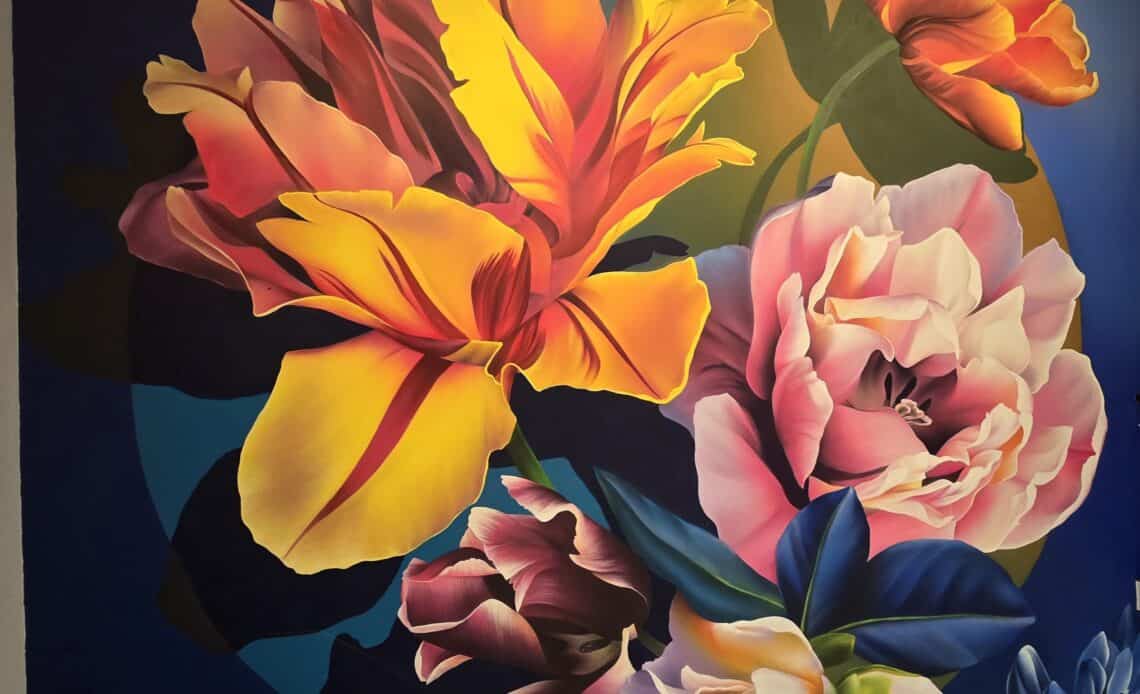
Have you ever truly seen a flower?
Not just glanced at its colour or inhaled its scent. But truly considered the brutal struggle, the perfect geometry, the ancient wisdom, and the explosive will to live contained within a single bloom?
I spent a day immersed in the SAATCHI Gallery’s breathtaking FLOWERS exhibition before it closes on the 9th of September 2025.
Stepping into the FLOWERS – Flora in Contemporary Art & Culture exhibition at the Saatchi Gallery is like walking through a living poem: a sensory and symbolic journey that blooms across two floors, culminating in nine immersive rooms and over 500 artworks.
It was a pilgrimage through the deepest metaphor we have. Below is my heartfelt reflection on how this floral universe weaves powerful lessons in mindset, intentional living, and resilience into its stunning artistry.
I think it is a fabulous exhibition and one not to miss. Secure your tickets today (see below in the FAQs for the link). Also, I captured alot of the photos within this post, providing a comprehensive preview of what awaits you during your visit.
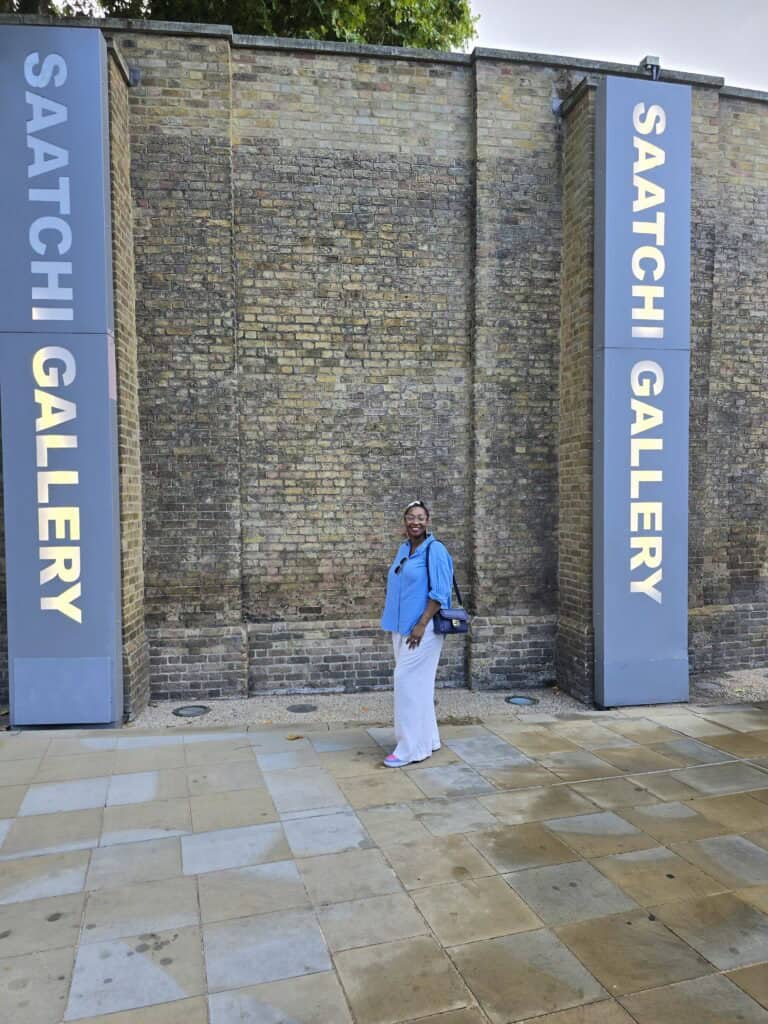
FAQs
Location: Saatchi Gallery, Duke of York’s HQ, King’s Road, London, SW3 4RY.
The Gallery is located approximately 300 yards along the King’s Road from Sloane Square. If travelling from Sloane Square, the Gallery is set back from the road on the left as part of the Duke of York’s Square complex.
Nearest Underground Station: The gallery is 3-4 minutes walk from Sloane Square Underground (District and Circle lines) and 20-25 minutes’ walk from Victoria (Victoria, District & Circle lines).
Cost: Ranges from £18 – £20 for adults; children under 6 go free
Opening times: Monday to Sunday: 10am – 6pm (last entry is 4:30pm)
Where to buy your ticket – Saatchi Gallery online (Once bought, you only need to show the QR code for your entry time to be allowed in.)
How long do you need for the exhibition? – Plan for at least 2hours. Personally, my preference would be up to three hours if you want to soak it all in. If you are with young children, there are seats where they can take a short break.
Is it ok to bring children to the exhibition? Children older than 5 years will enjoy the exhibition.
What not to expect? – There are no character meet and greets.
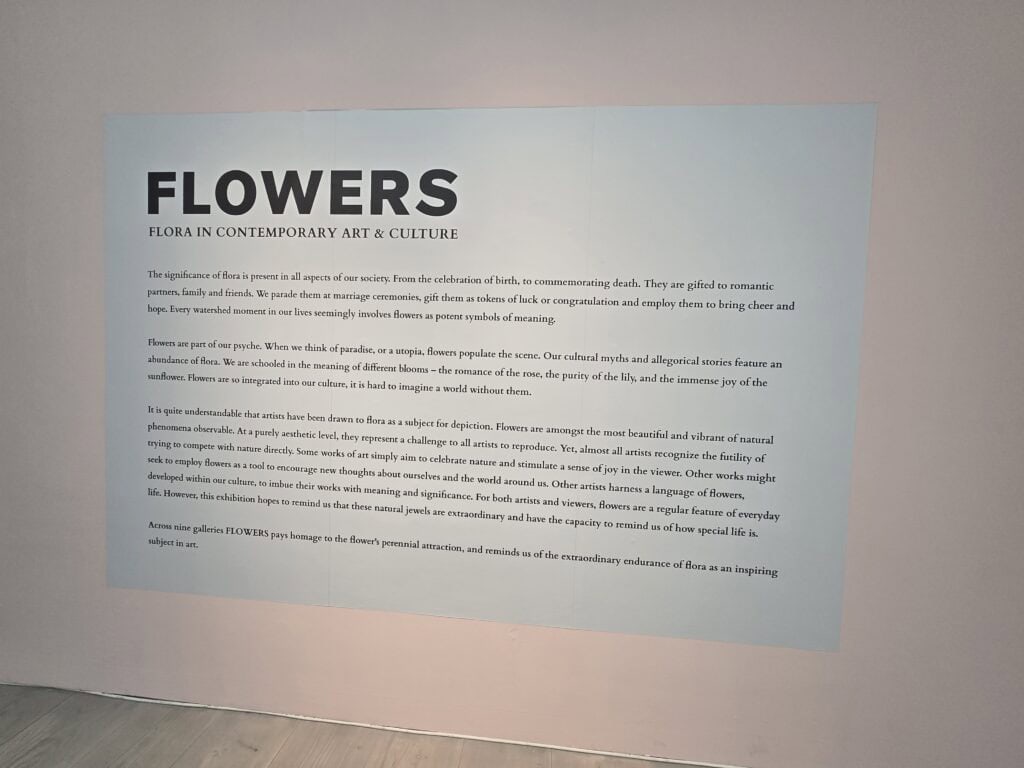
Related Post:
A Floral Metaphor for Life’s Mindset and Resilience
On entry, Sophie Mess’s mural “Journey of Progress” covers 50 square meters of a stairwell. It starts with soothing blues at the bottom, which stand for peaceful early growth, and moves up to blazing yellows and oranges, which stand for breakthroughs and strong advancement.
Walking through Saatchi Gallery’s FLOWERS exhibition was a mirror held up to life. Across nine meticulously curated rooms, from “Roots” to “New Shoots,” flowers became metaphors for how we grow, adapt, and flourish. Here’s the journey, room by room, and what it teaches us about living with intention.
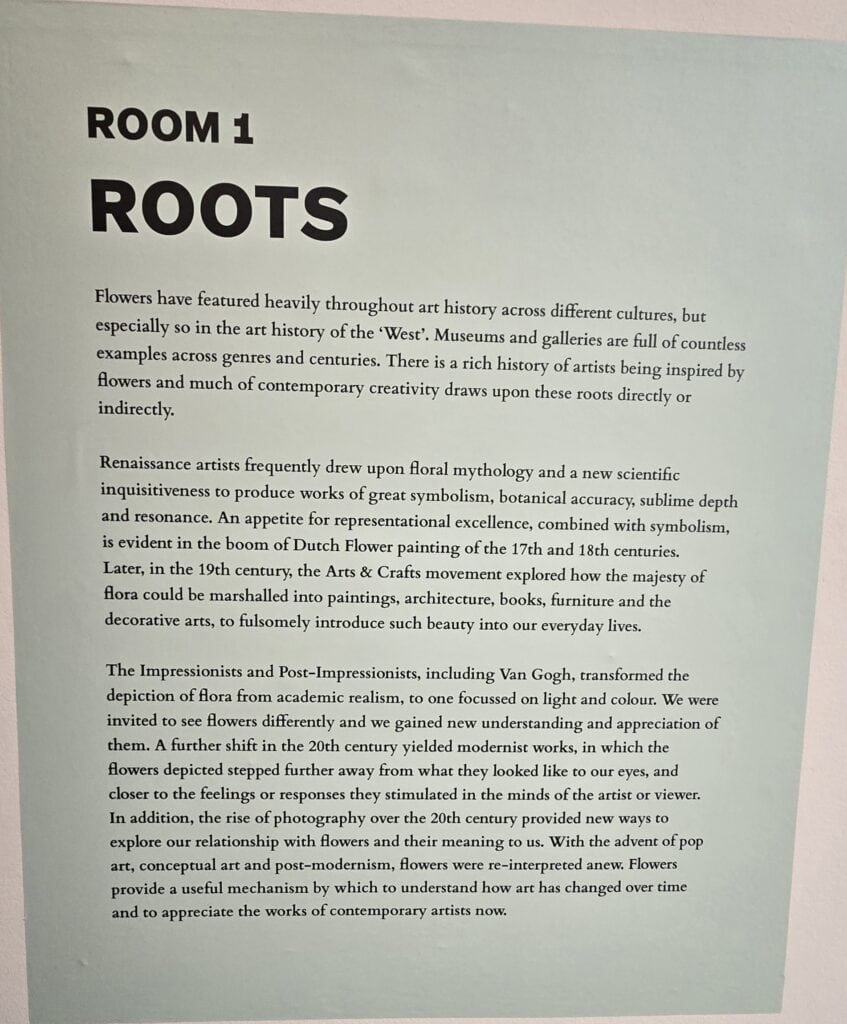
Room 1: Roots – The Hidden Foundation of Growth
“Roots” is the first part of the exhibit. It shows floral paintings from the Renaissance to Dutch flower painting and the Arts & Crafts Movement. It looks at how flowers have always stood for symbolism, precision, and human inquiry.
This foundational journey reminds us: growth begins with a grounded understanding of our past, heritage, and internal strength. The journey begins in the dark, in the soil. The exhibition starts with the unseen: the intricate, tenacious root systems that anchor and nourish. Before any glory, there is this hidden work.
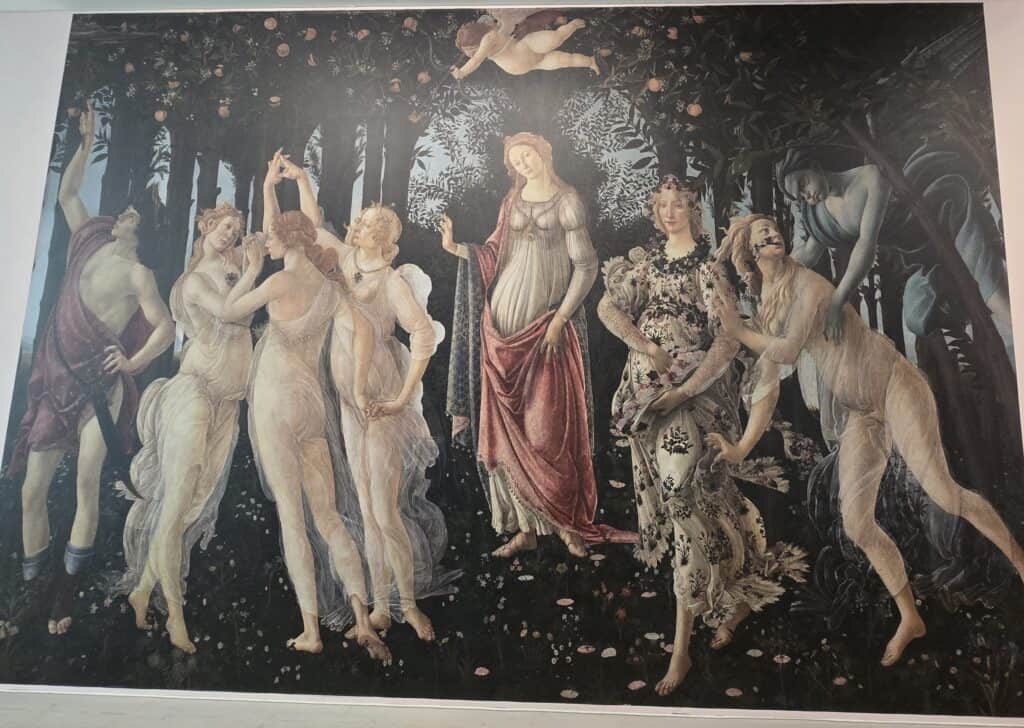
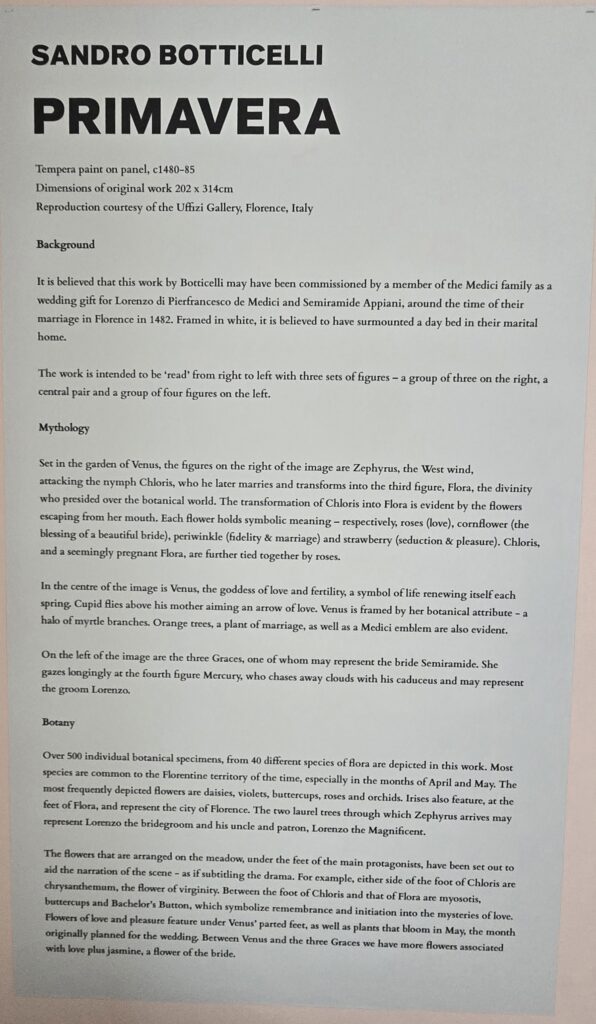
My reflection: You cannot bloom without a strong foundation. Your roots are your values, your non-negotiables, your mental health, your support system. True growth starts in the dark, where resilience is built. Nurture what no one sees.
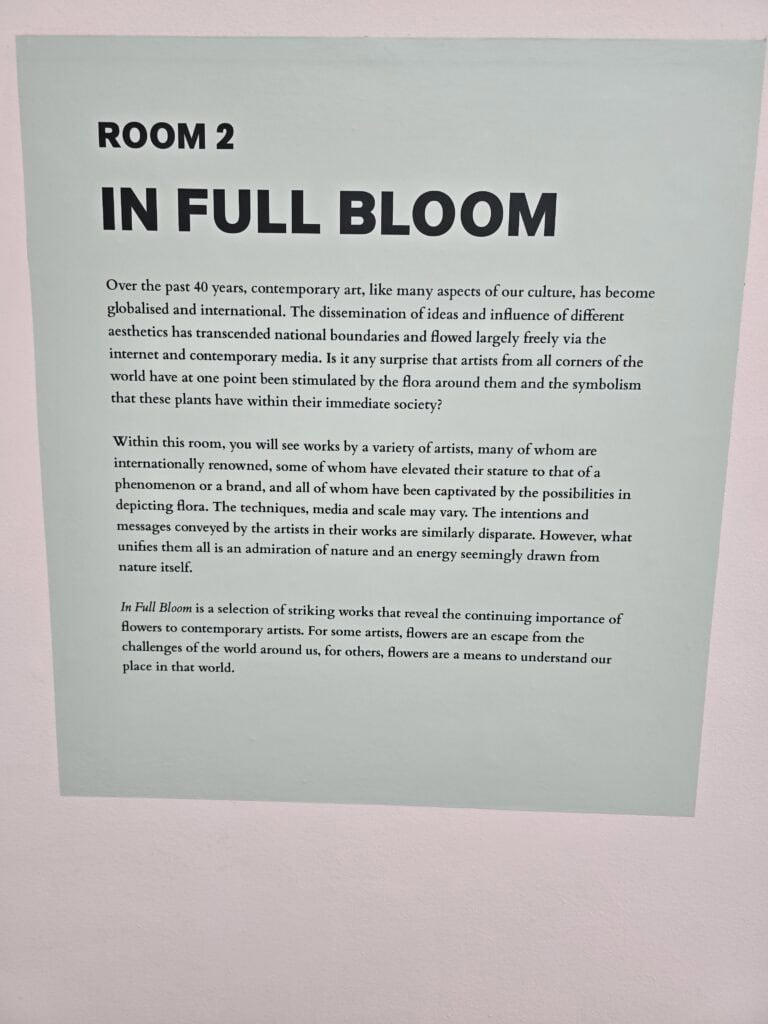
Room 2: In Bloom – The Courage to Be Seen
From the quiet soil, the exhibition erupts into colour. Bursting petals, radiant blossoms, flowers in their full glory. This is the moment of courage: stepping into visibility, unapologetically occupying space.
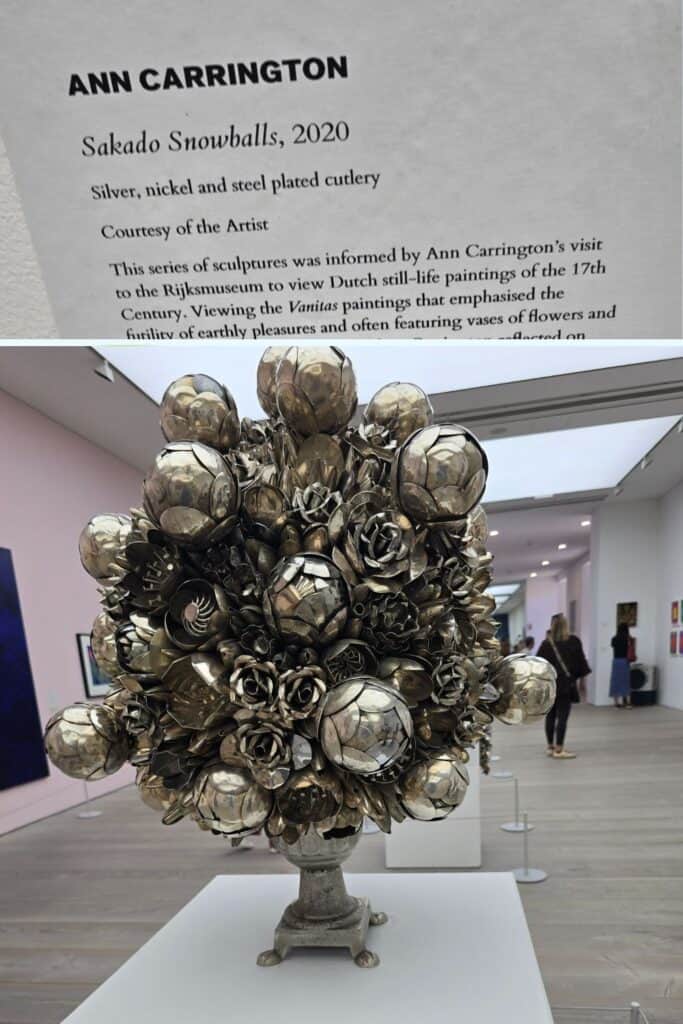
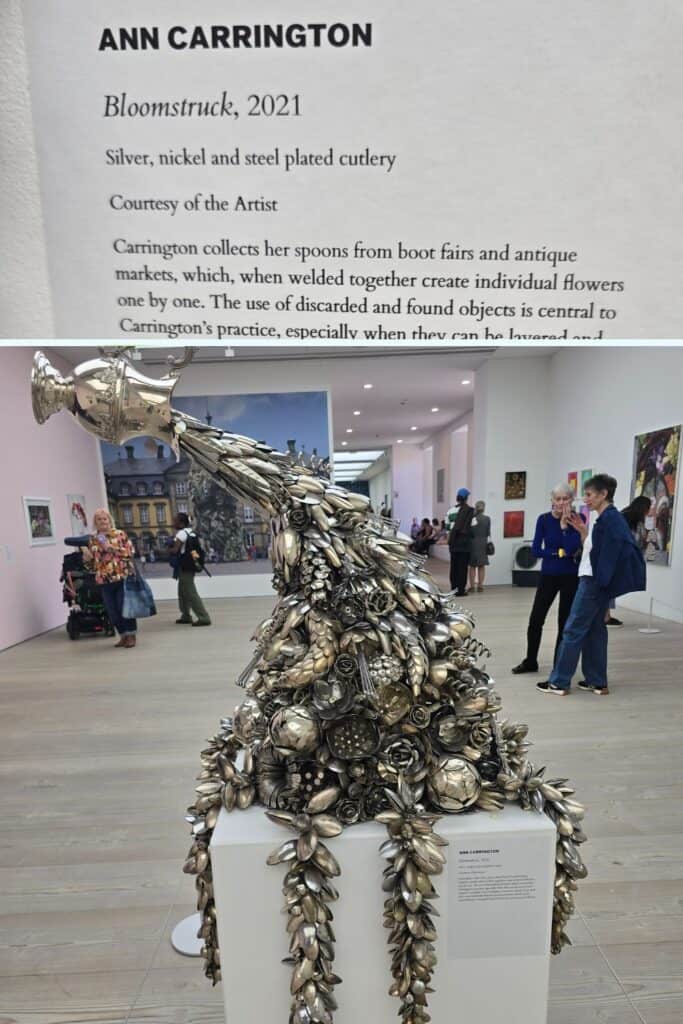
Ann Carrington’s Sakado Snowballs and Bloomstruck, forged from silver, nickel, and steel-plated cutlery, transform everyday utensils into extraordinary blooms. What was once ordinary becomes eternal sculpture, blurring the line between utility and beauty.
Yet beneath the shimmer lies a quiet reminder: even the most dazzling creations echo impermanence. Flowers, like us, bloom brilliantly, but they do not last. The art whispers memento mori: remember that you must die, so live fully, intentionally, and beautifully while you can.
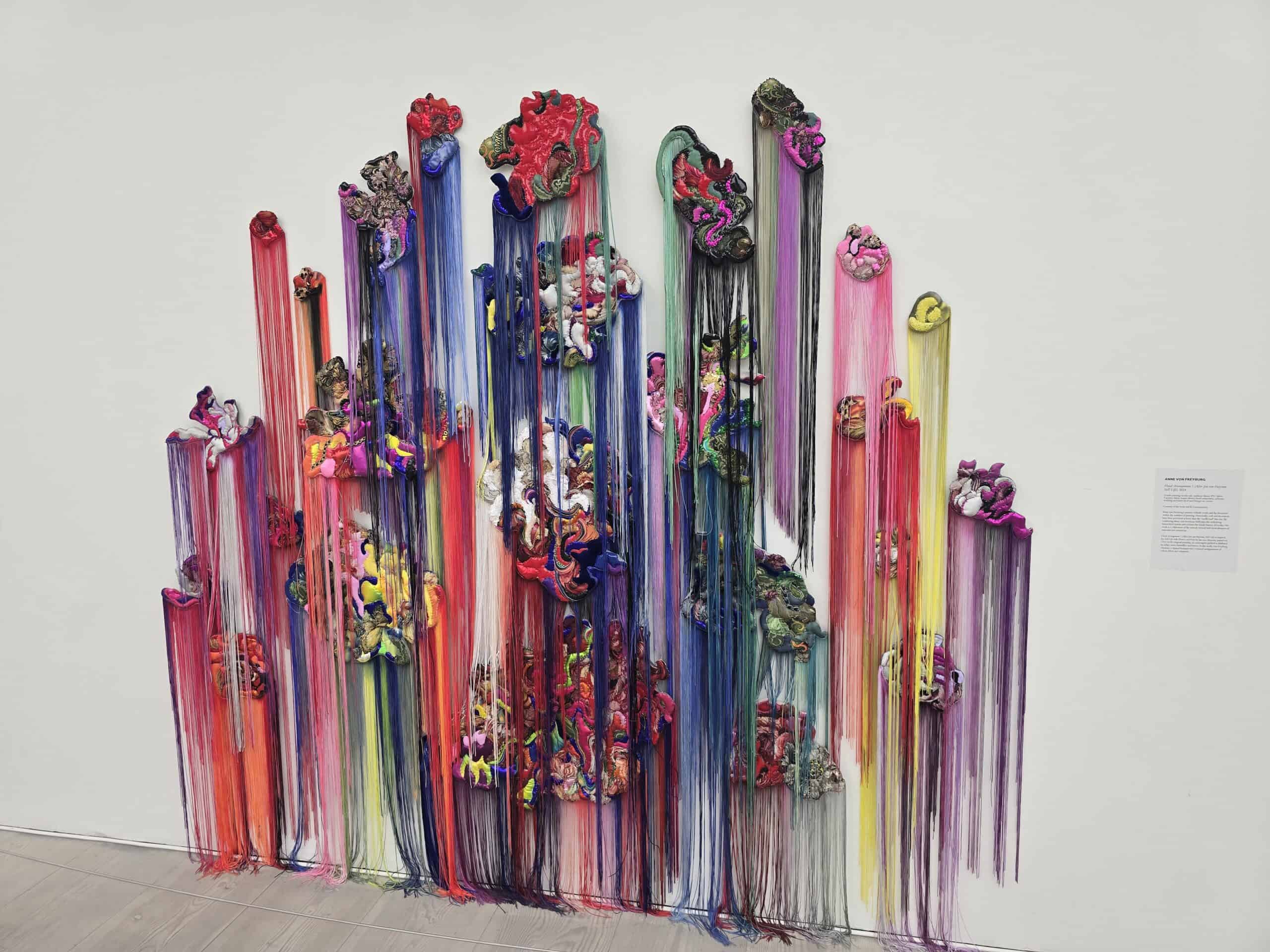
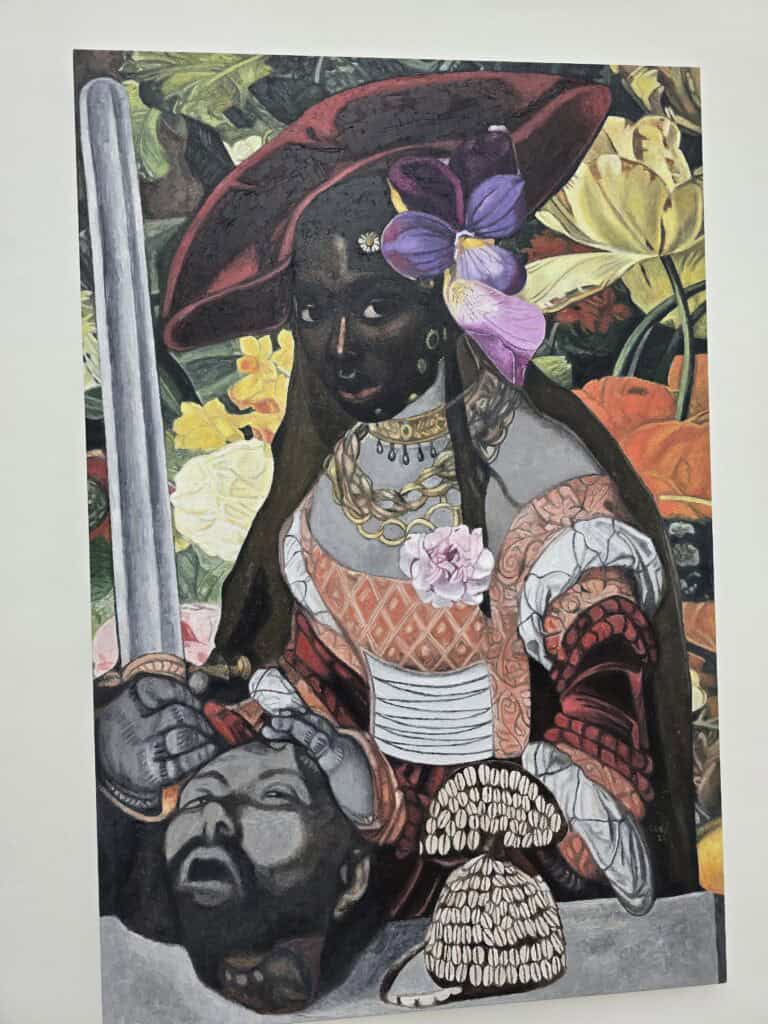
My reflection: Blooming is risky; it means vulnerability, exposure, and possibility of critique. But it is also power. Like a flower in full sun, growth requires us to stand tall, unhidden, in the fullness of our expression.
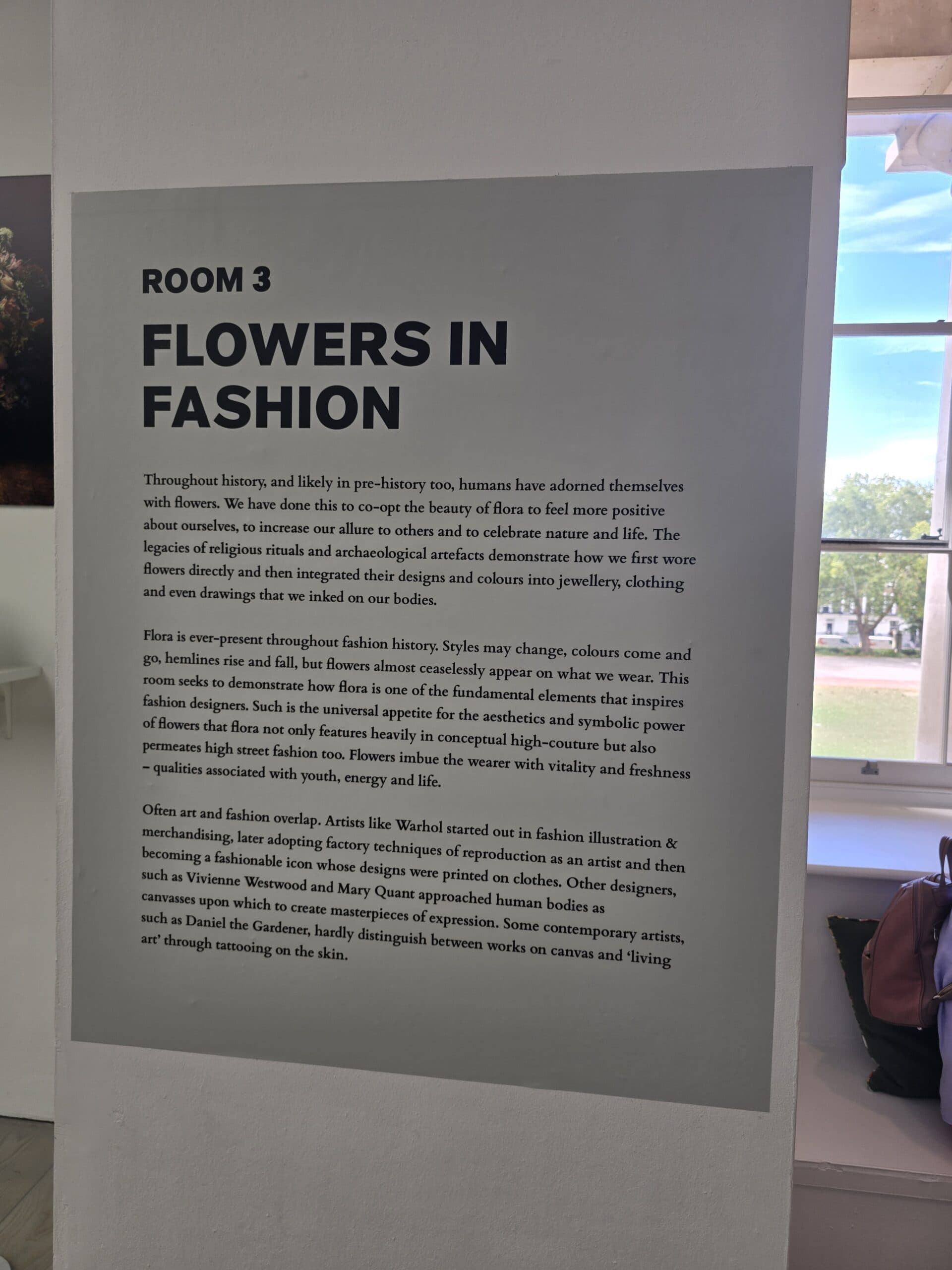
Room 3: Flowers in Fashion – Becoming the Statement
Flowers emerge from the yard and enter the runway in this room. Haute couture clothing, accessories, and fabrics turn flowers into a way of life, sophisticated elegance that is purposefully worn and conspicuously displayed. Fashion transforms petals into power, as shown in Vivienne Westwood’s rebellious floral couture, Buccellati’s immaculate craftsmanship, and Marimekko’s bold journey from petal to pattern to clothing. You can see that fashion turns blossoms into identity, and I had so much fun in this room.
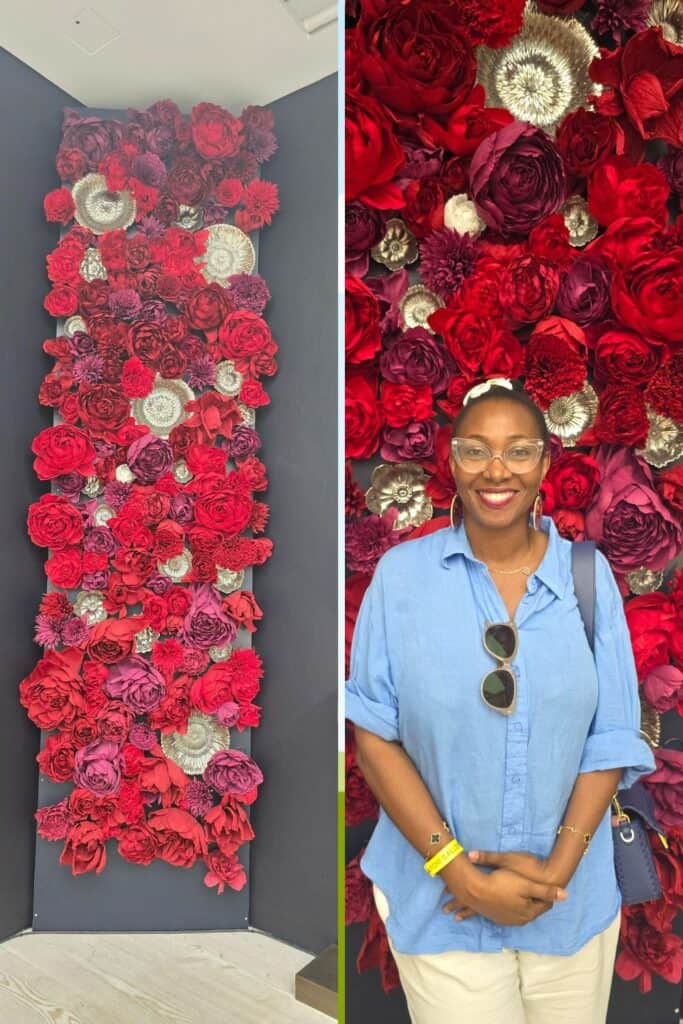
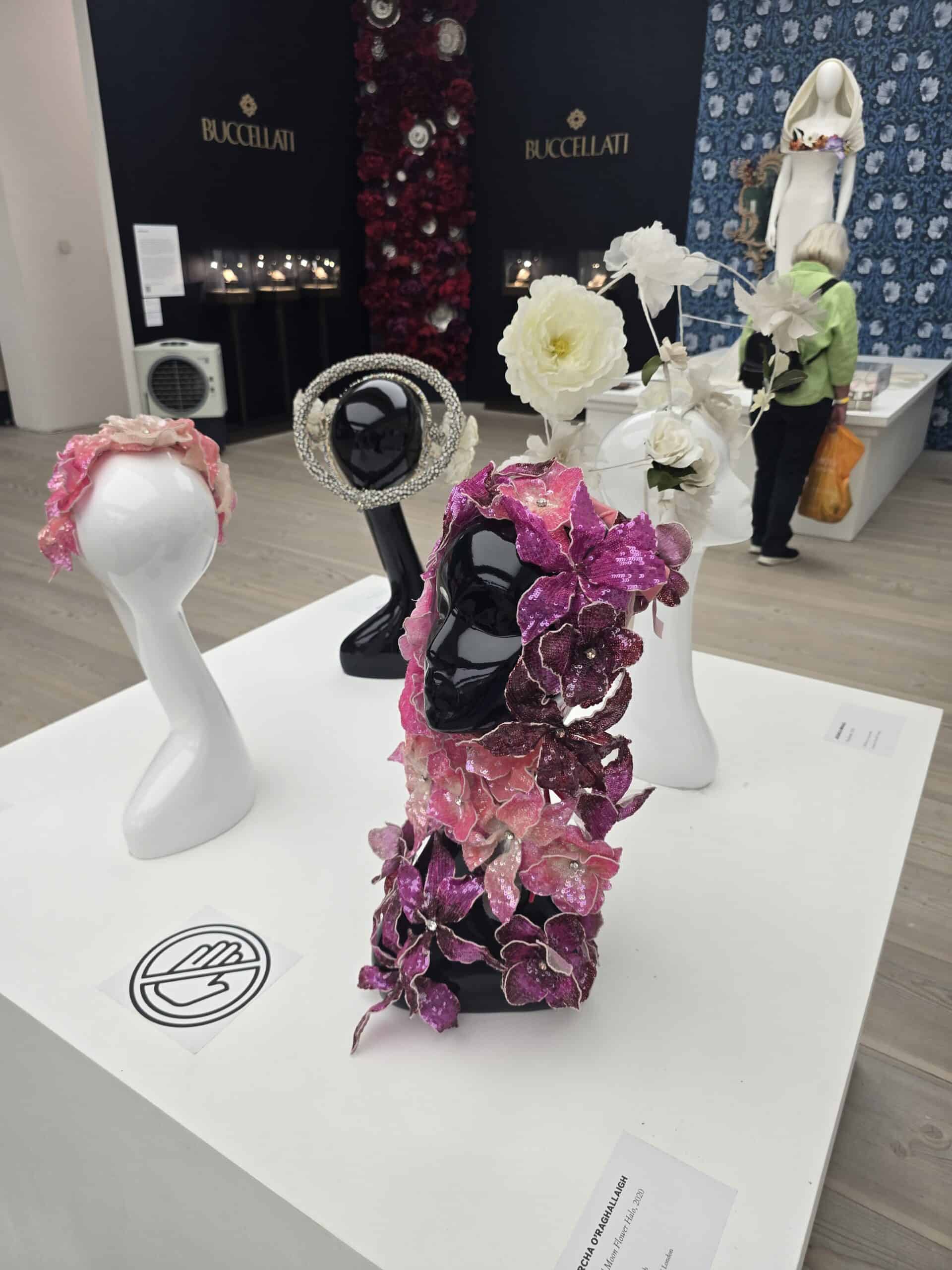
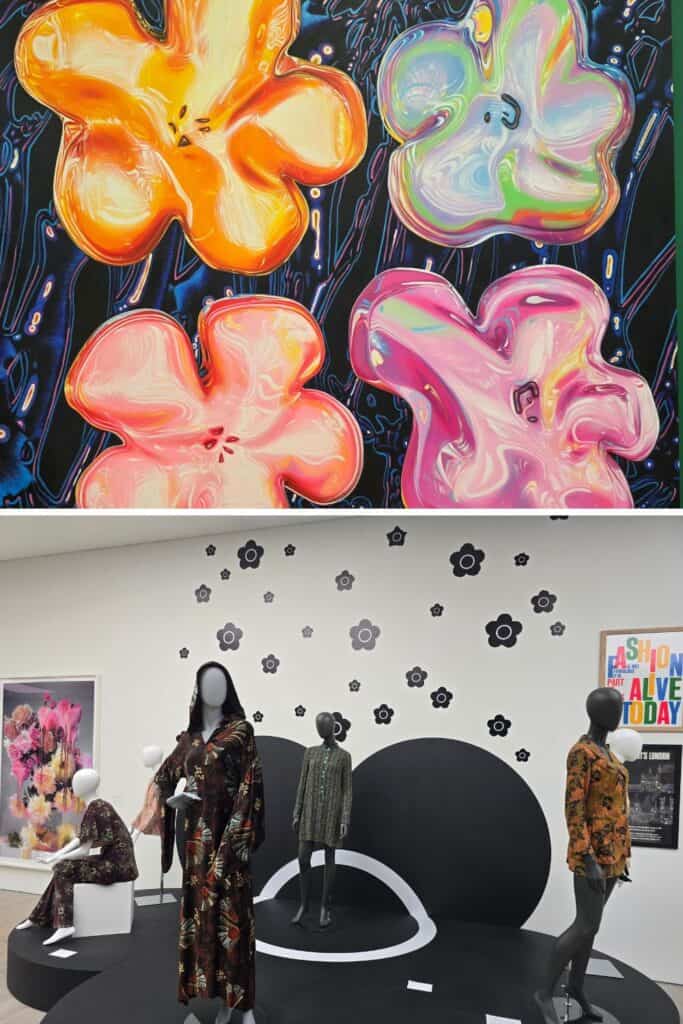
My Reflection: This is intentional living. Just as designers choose florals to express elegance, rebellion, or romance, we too can choose the way we “wear” our values. What you portray is a statement of who you are becoming, not a coincidence. Live consciously. You are the designer of your life.
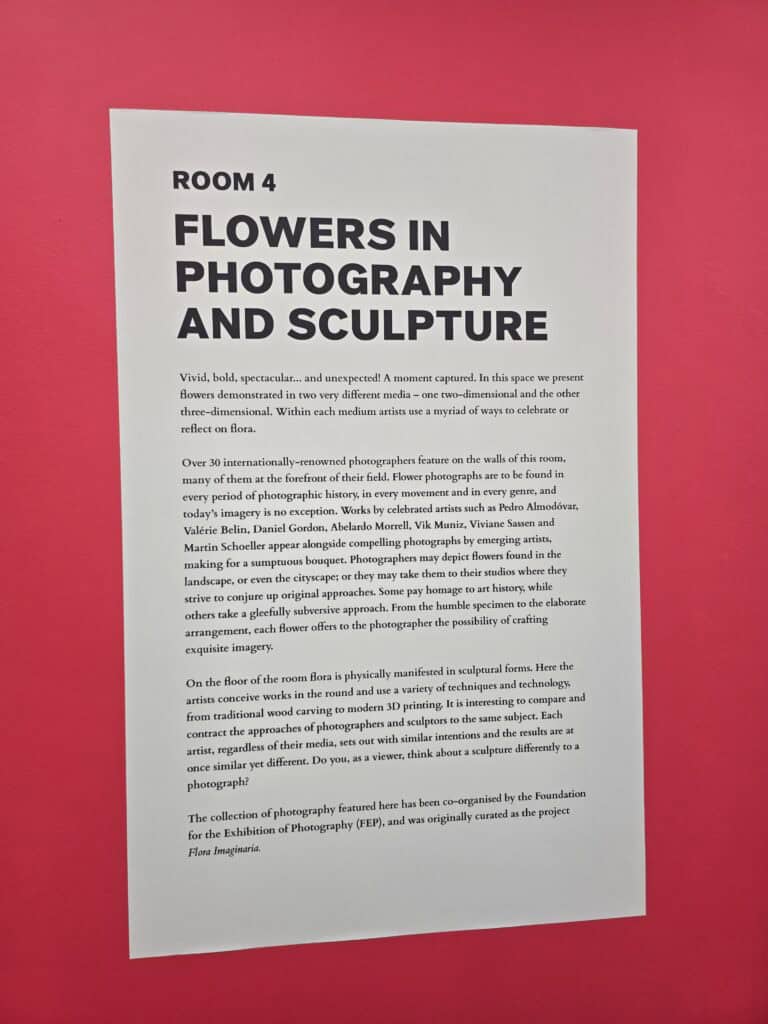
Room 4: Flowers in Photography and Sculpture – The Fleeting and the Eterna
Another favorite section where I spent a lot of time in. Here, flowers shift from fleeting to enduring, from a captured image to a sculpted form. Over 30 world-renowned photographers; from Pedro Almodóvar, Valérie Belin, Daniel Gordon, Viviane Sassen, Martin Schoeller and more, frame blossoms in ways that surprise and unsettle.
A single petal can be luminous against the vastness of a cityscape; a bouquet can feel like rebellion. Each photograph is proof that beauty is decorative, narrative, emotional, and subjective.
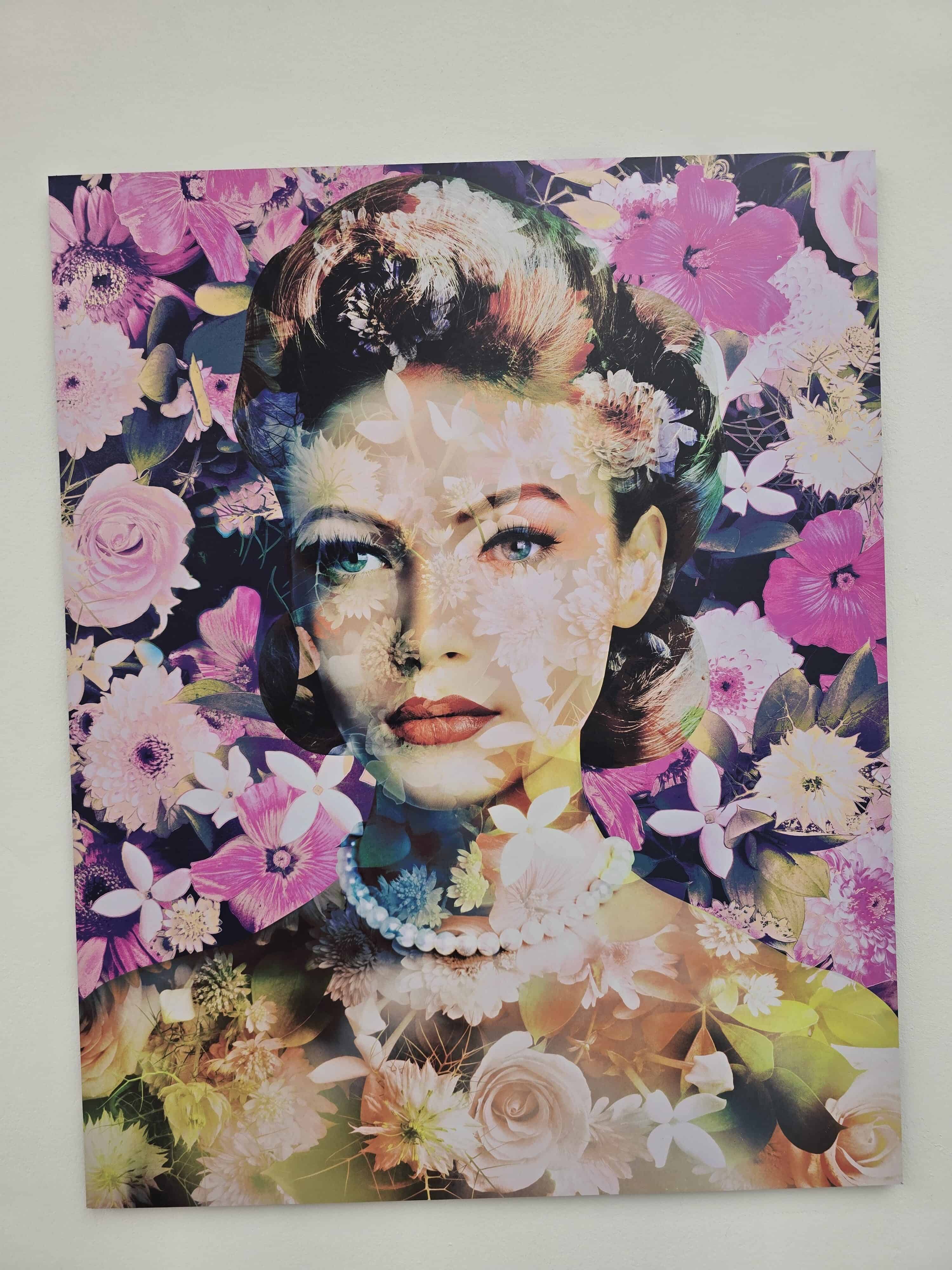
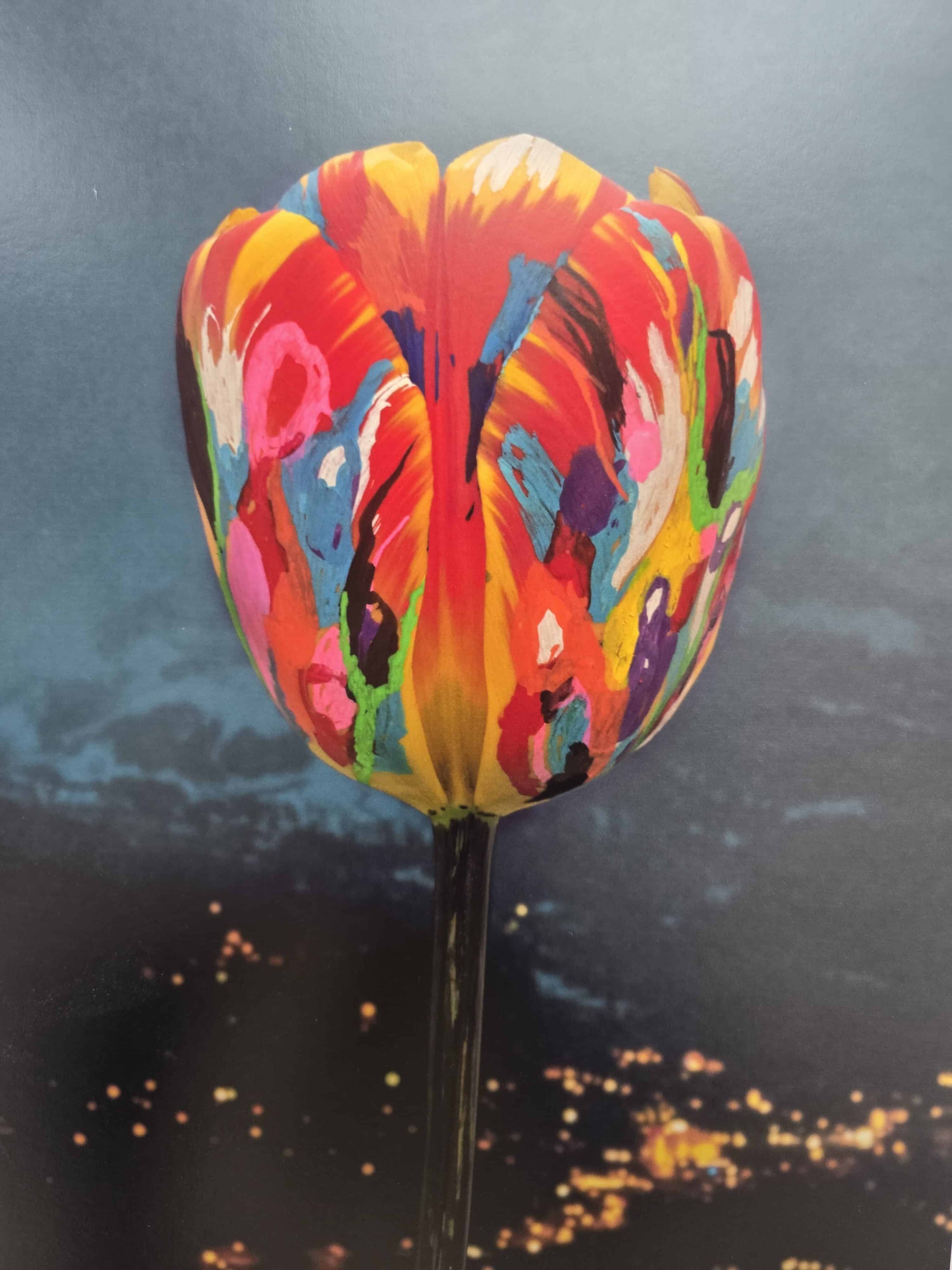
And then, the floor blooms in three dimensions. Flora is carved, cast, 3D printed, and reimagined in material form. In one corner, delicate stems rise from a deep cobalt base, impossibly fragile yet defiantly alive. These works remind us that what begins as soft and perishable can be made permanent, even monumental.Photographers like Pedro Almodóvar, Valérie Belin, and Viviane Sassen freeze fleeting beauty in unexpected ways, while sculptors carve, cast, and 3D-print blossoms into enduring form. One moment is ephemeral; the next, monumental.
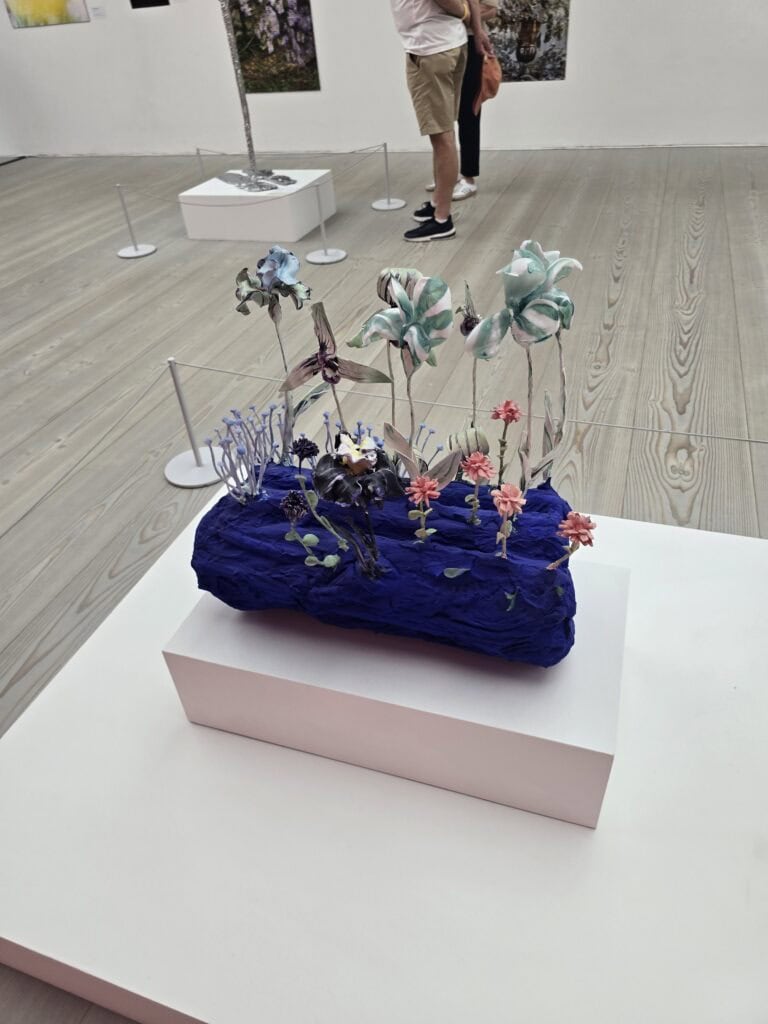
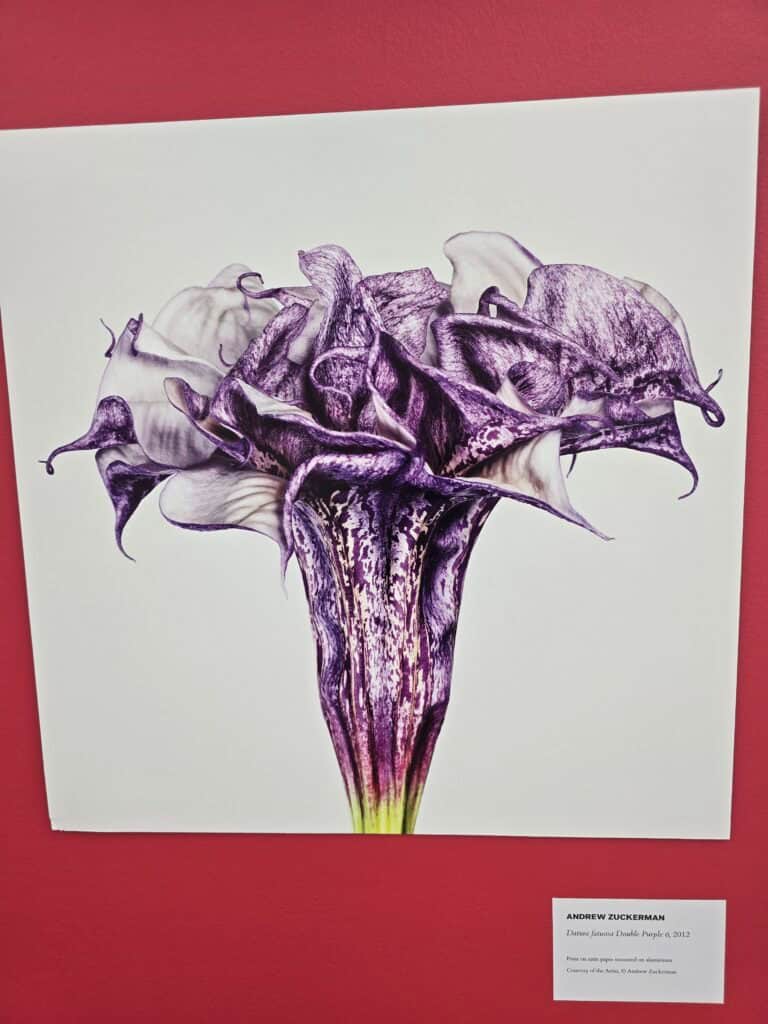
My Reflection: Life offers us both moments to capture and legacies to create. Photography teaches presence – freezing time, honouring what is here now while sculpture teaches endurance, transforming the fragile into the lasting. So too with mindset: some lessons are meant to be seized in the moment, others carved into our foundation. Resilience is knowing when to hold lightly and when to forge deeply. Flowers, whether photographed or sculpted, remind us that we are both fleeting images and enduring monuments.
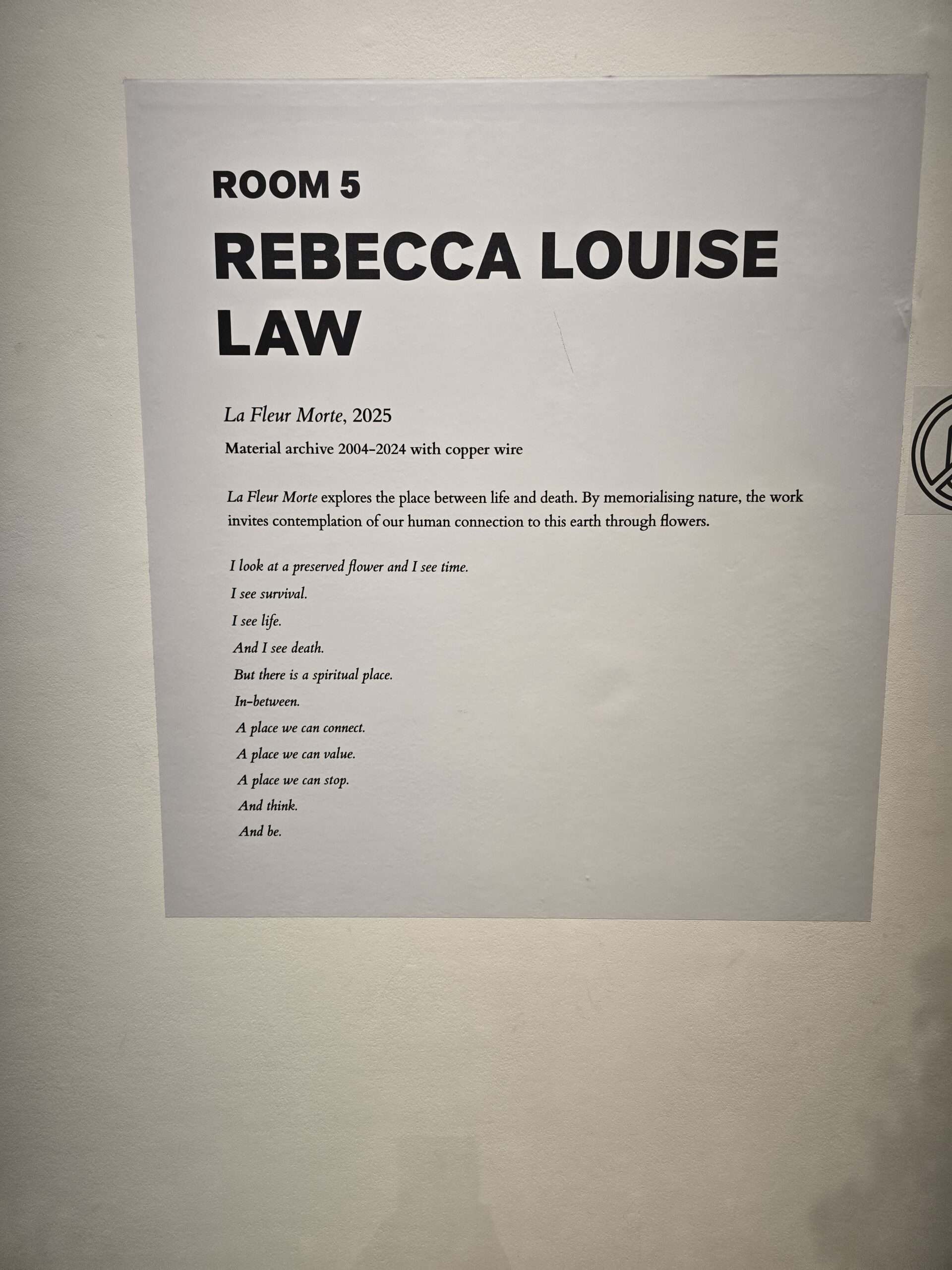
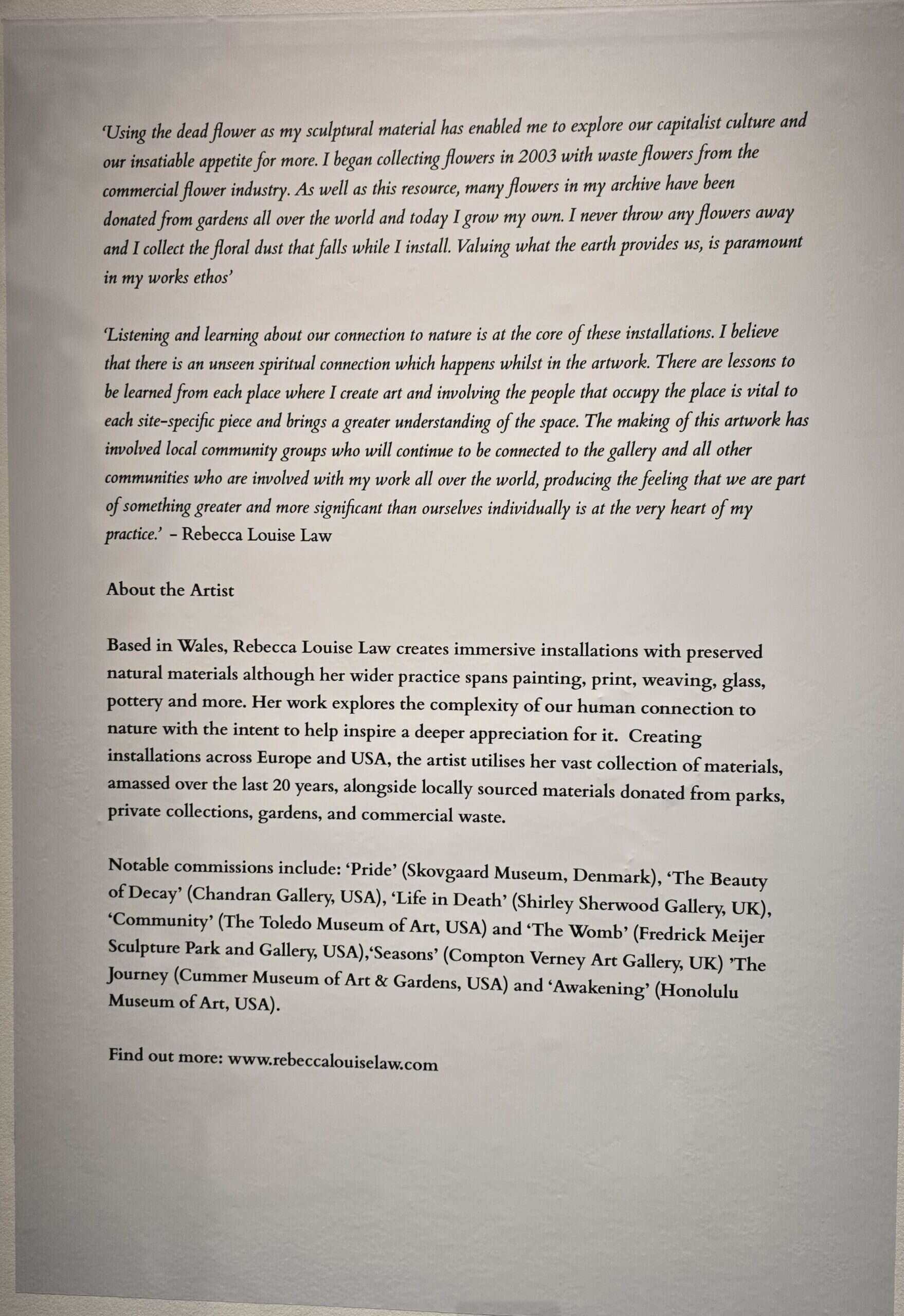
Room 5: Rebecca Louise Law – La Fleur Morte
Walking into Rebecca Louise Law’s La Fleur Morte is like stepping into a suspended garden of memory.
Here, thousands upon thousands of preserved, dried flowers hang from the ceiling, a cascading tapestry of muted golds, russets, and deep purples. You don’t just view this installation; you enter it. You move through a fragrant forest of memory, each crunch underfoot a whisper of a life once lived.
This is the culmination of a twenty-year archive: a testament to an insatiable appetite not for consumption, but for conservation. This is not the freshness of spring but the poetry of decay. Law invites us to stand beneath what was once alive, to marvel at beauty even in its withering, to face the truth we so often turn away from: nothing lasts forever.
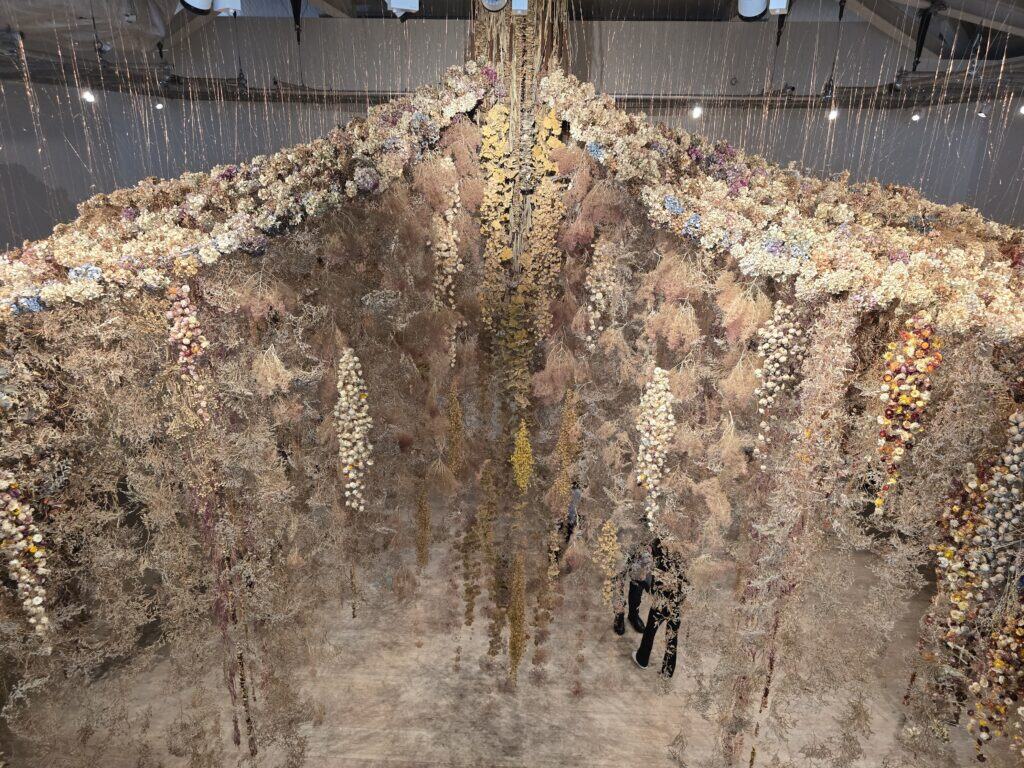
Law’s work is a profound critique and a beautiful rebellion. She sources her materials from the waste of the commercial flower industry, from global gardens, and now from her own soil. In her practice, nothing is discarded.
Not a single petal, not even the “floral dust” that falls during installation. This ethos is a radical act in our capitalist culture: it forces us to confront the value of what the earth provides and to question our own throwaway habits.
She speaks of an “unseen spiritual connection” that occurs within the artwork. As you walk beneath the delicate, suspended canopy, you feel it: a hushed reverence, a collective intake of breath. This is Law’s ultimate goal: to make us feel part of something greater than ourselves.
By involving local communities in the creation of her site-specific pieces, she weaves human connection directly into the fabric of nature’s cycle. The installation becomes a living, breathing entity, born from collaboration and sustained by collective care.
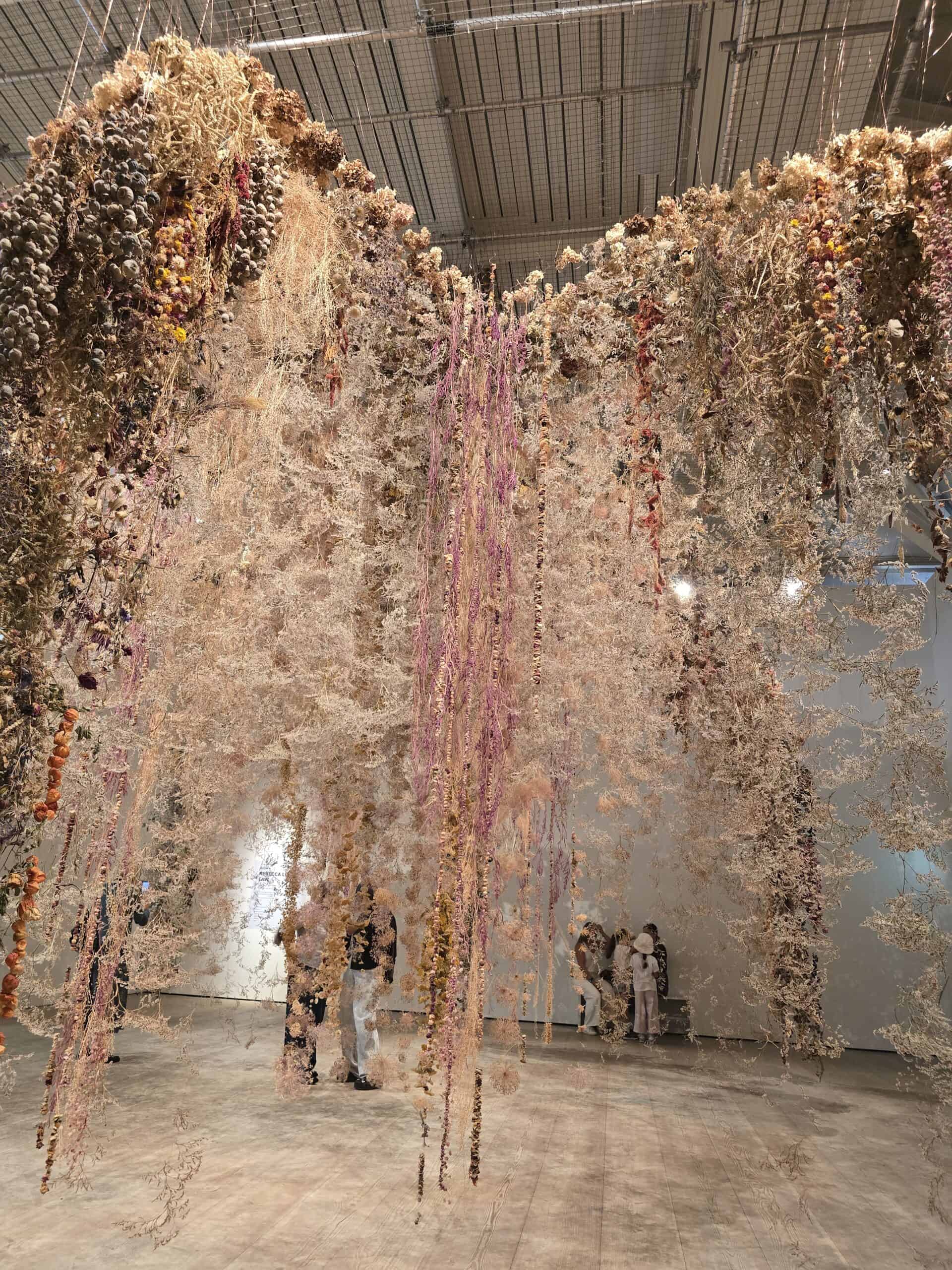
In this fragility, there is resilience. These blooms did not vanish but were transformed. Their preserved forms remind us that endings are not erasures but evolutions. Just as flowers move from vibrant life to stillness, so too do our own seasons shift. The art whispers a lesson in courage: do not fear the passing of time, for even in decline, there is meaning, memory, and magnificence.
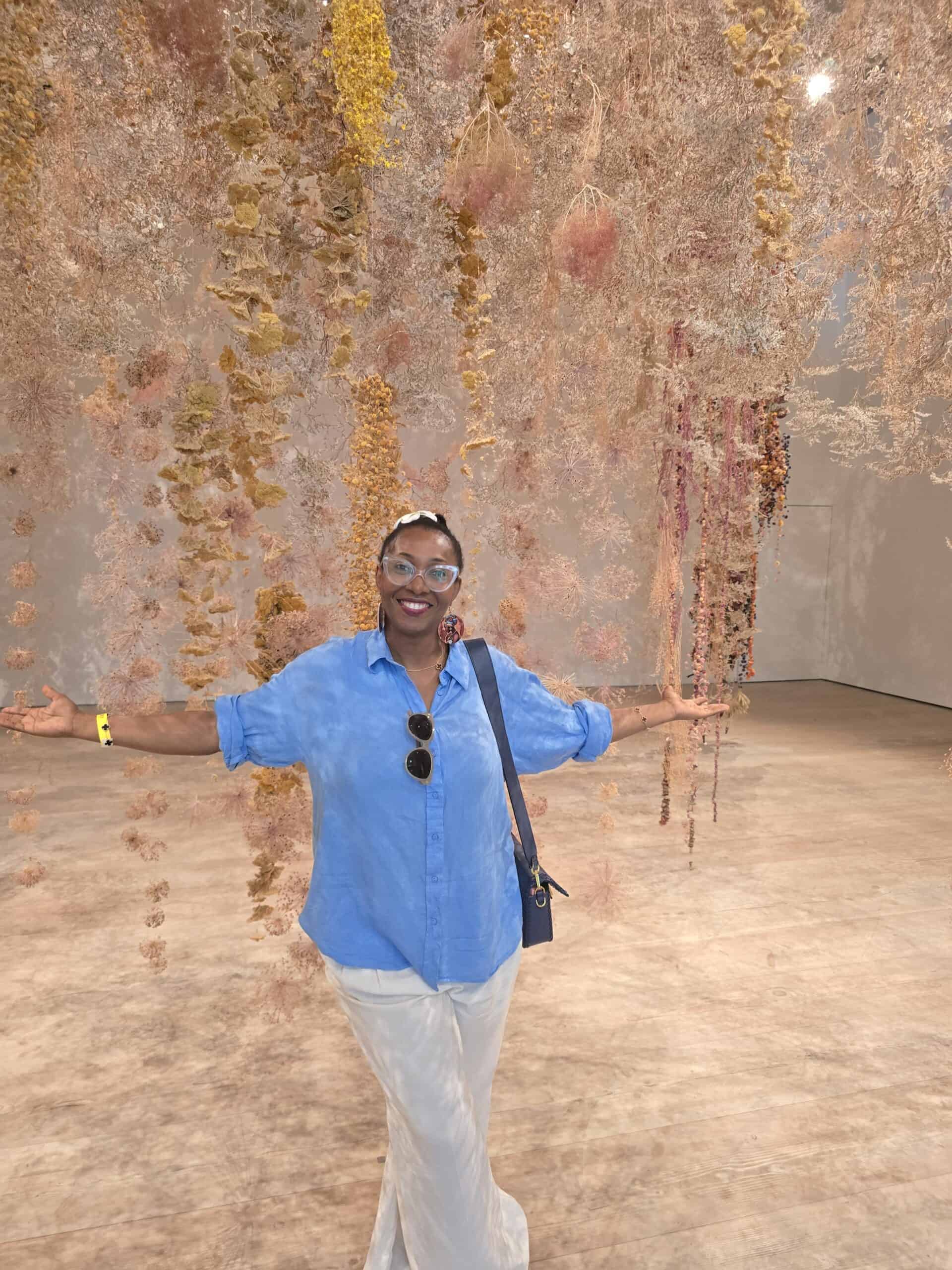
My Reflection: La Fleur Morte is a meditation on impermanence and endurance. Rebecca Louise Law’s room holds a mirror to our own lives. We are taught to fear wilting, to hide our dormant phases, to equate beauty only with bloom.
- But what if our most powerful state is not perpetual flowering, but transformative preservation? This room urges us to live with intention, to embrace change rather than resist it, and to see beauty not just in the bloom, but in the withering. To remember: every ending is also a form of preservation.
- What if our perceived failures, our faded moments, are not waste? What if they are simply being preserved, gathered, and woven into the stunning tapestry of our experience, giving it depth, texture, and a beauty that is more complex and enduring than mere perfection?
- What if true resilience isn’t about avoiding death, but about understanding its role in rebirth? Law teaches us that everything has value. Every setback, every ending, every bit of “dust” from our struggles is material for our next creation.
This room is a breathtaking masterclass in intentional living. La Fleur Morte asks us to pause, to listen, and to honor the sacredness of every stage of life, especially the ones we’re taught to overlook. To stand among its suspended blooms is to realize that even in stillness, there is vitality; even in silence, there is profound meaning. It teaches us to hold the past not as weight, but as fertile ground from which future growth emerges.
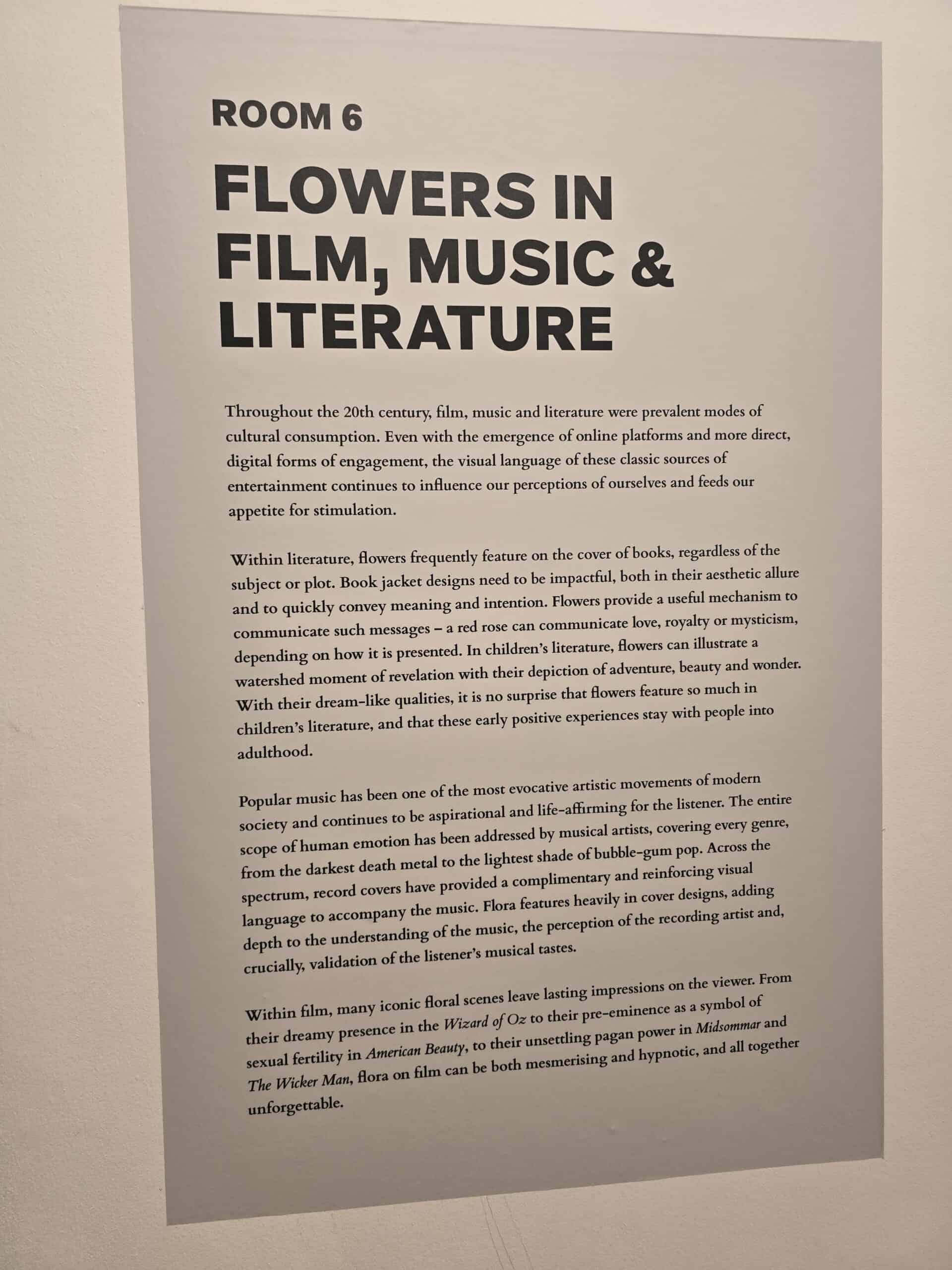
Room 6: Flowers in Film, Music & Literature – The Language of Petals
We do not simply grow flowers; we dream them, we sing them, we write them into being. This room reveals flora as one of humanity’s oldest and most potent languages; a silent script that has shaped our stories, our art, and our collective imagination. The garden is not their only home; their truest habitat is culture itself.
Long before algorithms curated our tastes, flowers were already curating our emotions: on book covers, record sleeves, and silver screens. A single bloom could say what words could not.
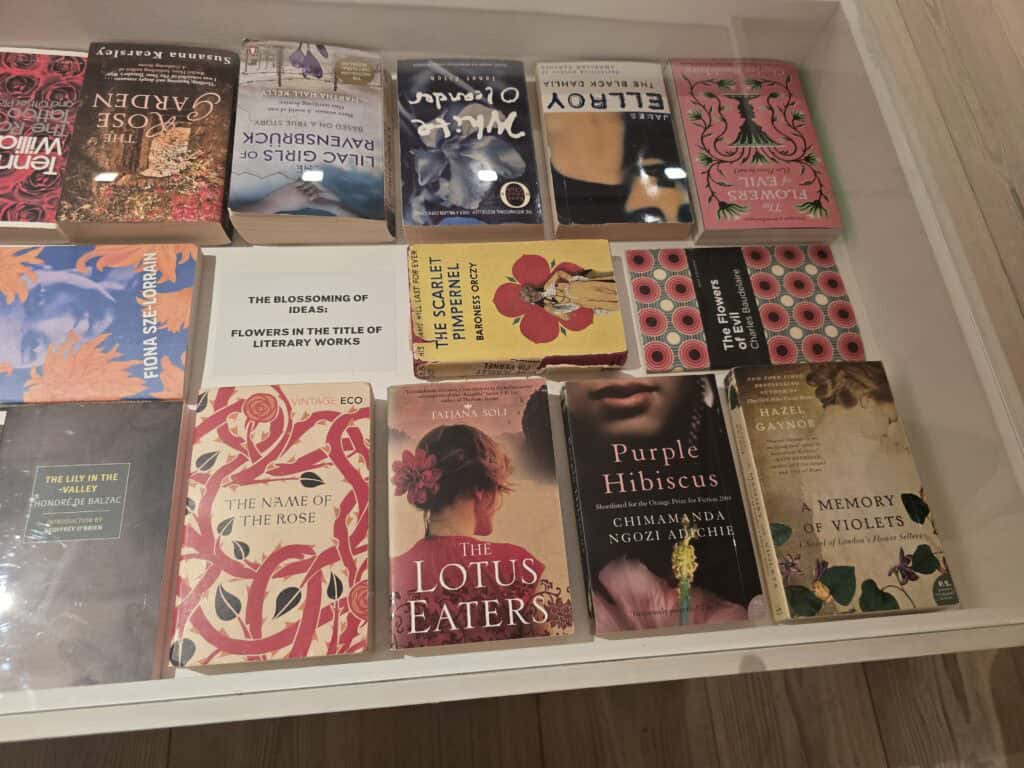
In literature, a flower on a cover is both promise and portal. A rose whispers of passion, secrecy, or loss before the first page turns; in children’s tales, blossoms are doorways into wonder, teaching us how to feel before we learn how to think.
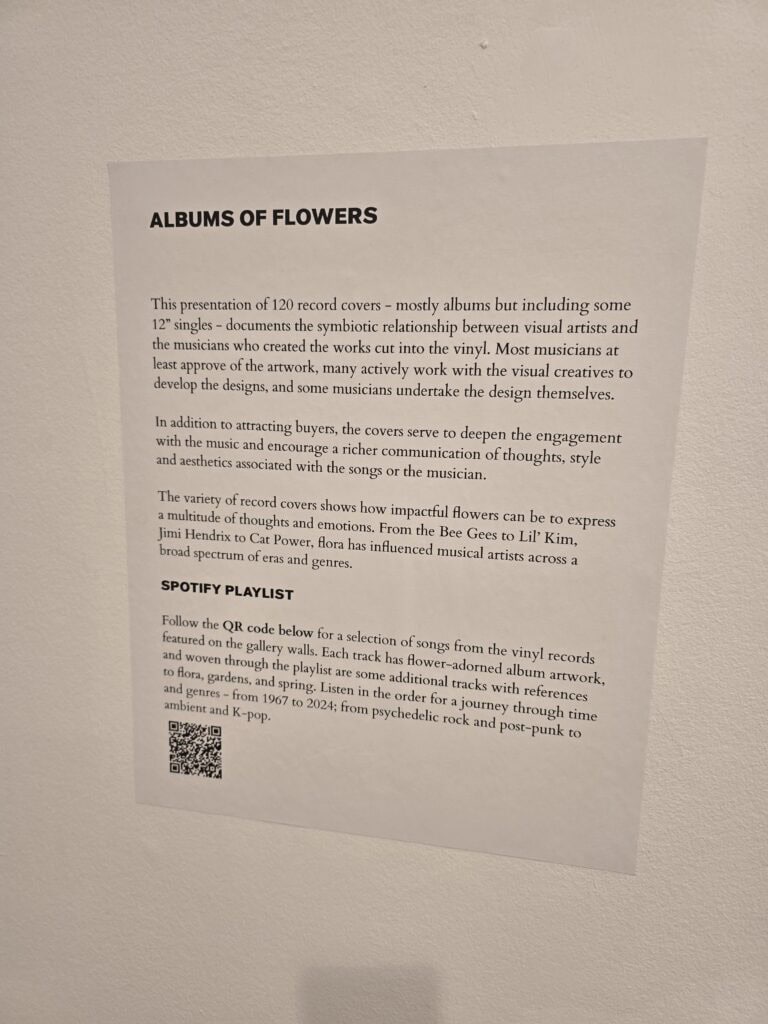
In music, album covers adorned with flora strike the first chord before the needle drops. A daisy might signal innocence, a psychedelic bloom rebellion. Flowers become badges of belonging, visual cues that tell us: This song understands you.
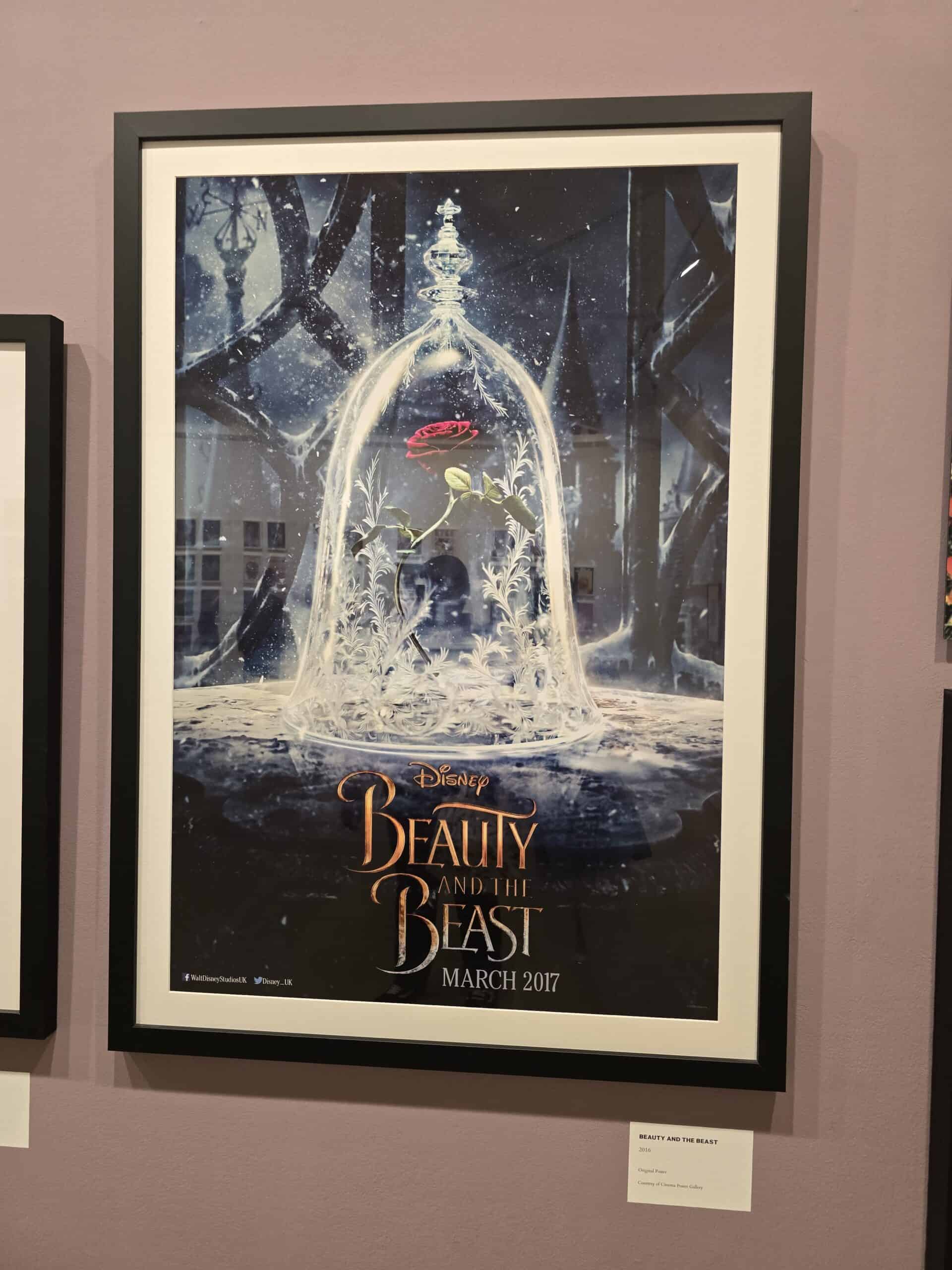
In film, flowers are never passive scenery. They seduce and unsettle, from the poppy field in The Wizard of Oz to the rose in Beauty And The Beast.. On screen, a flower is never just a flower, it is a vessel of desire, danger, or transformation.
My Reflection: This room is an invitation to author your own symbolism. What would be the cover art of your life right now? What blooms compose your soundtrack? What scenes are you directing in your own film?
Like writers, musicians, and filmmakers, we too can choose the symbols that define us. Be deliberate with the images you project, the voices you let in, and the stories you script. Flowers remind us that life is both narrative and metaphor, and that the most powerful language is often unspoken.
We are all living our own epic. Choose your bloom, and let it tell your story.
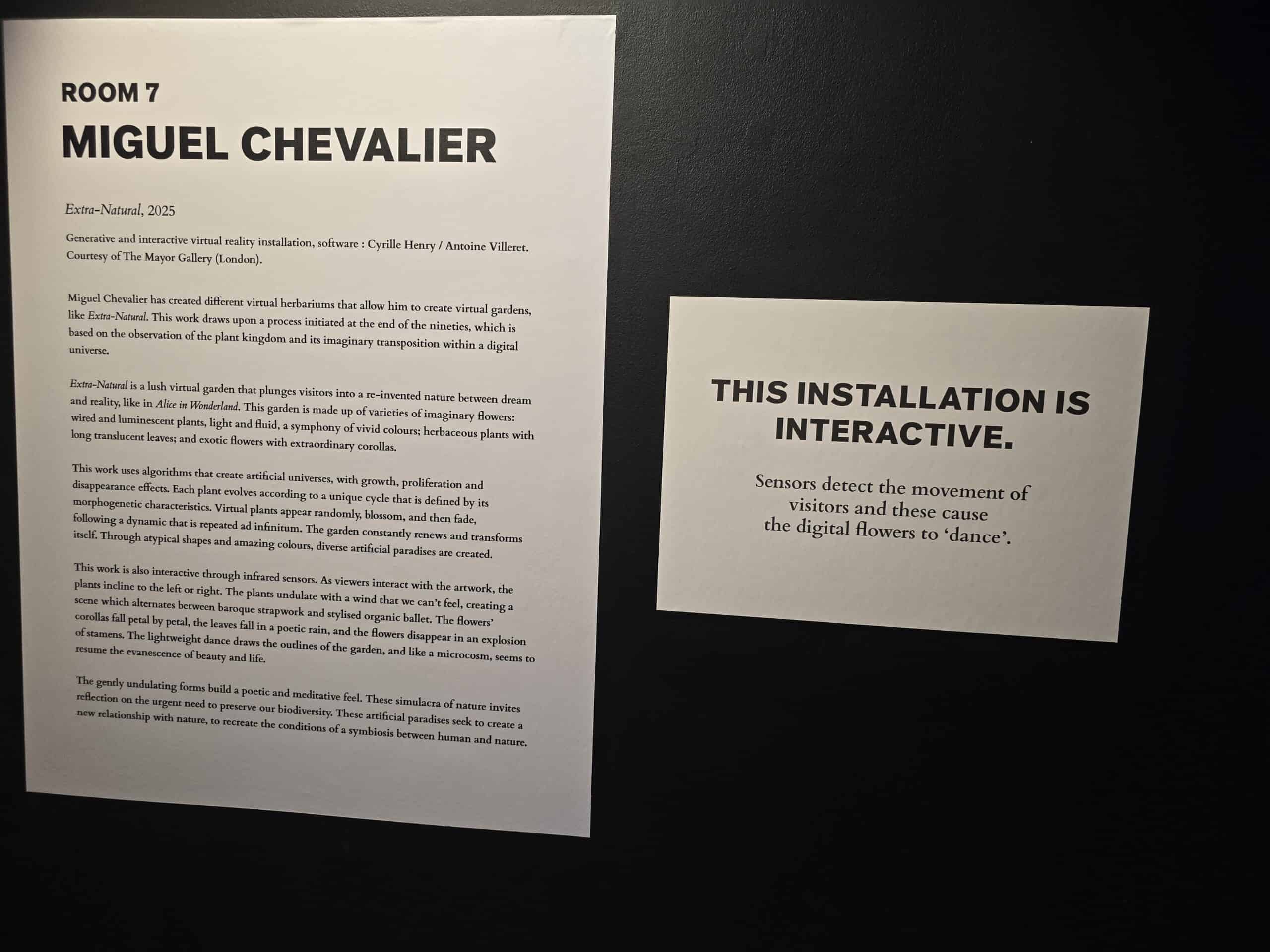
Room 7: Miguel Chevalier – The Digital Garden
Miguel Chevalier’s Extra-Natural is a pulsating, algorithmic universe where digital flowers bloom and vanish in an endless loop of life and death.
Chevalier, a pioneer of digital art, has used algorithms to craft a lucid dream of a garden. Here, flora is both familiar and utterly alien: flowers with luminescent corollas, plants with long, translucent leaves that sway to an unfelt wind, a symphony of vivid, impossible colours. It is a scene of baroque extravagance and hypnotic serenity, straight out of Alice in Wonderland’s most inspired dream.
This is a living ecosystem. Each plant, coded with unique DNA, grows and dies before your eyes. And it reacts to you.
Infrared sensors detect your movement. As you step closer, reach out, or move through the space, the plants react. They bend and sway, parting before you like a digital Red Sea, dancing to your unique rhythm.
You are no longer a passive observer; you are rain, you are sunlight, you are the wind. You are a force of nature within nature itself.
My Reflection: Chevalier’s work is a profound metaphor for our modern existence and a powerful lesson in mindset.
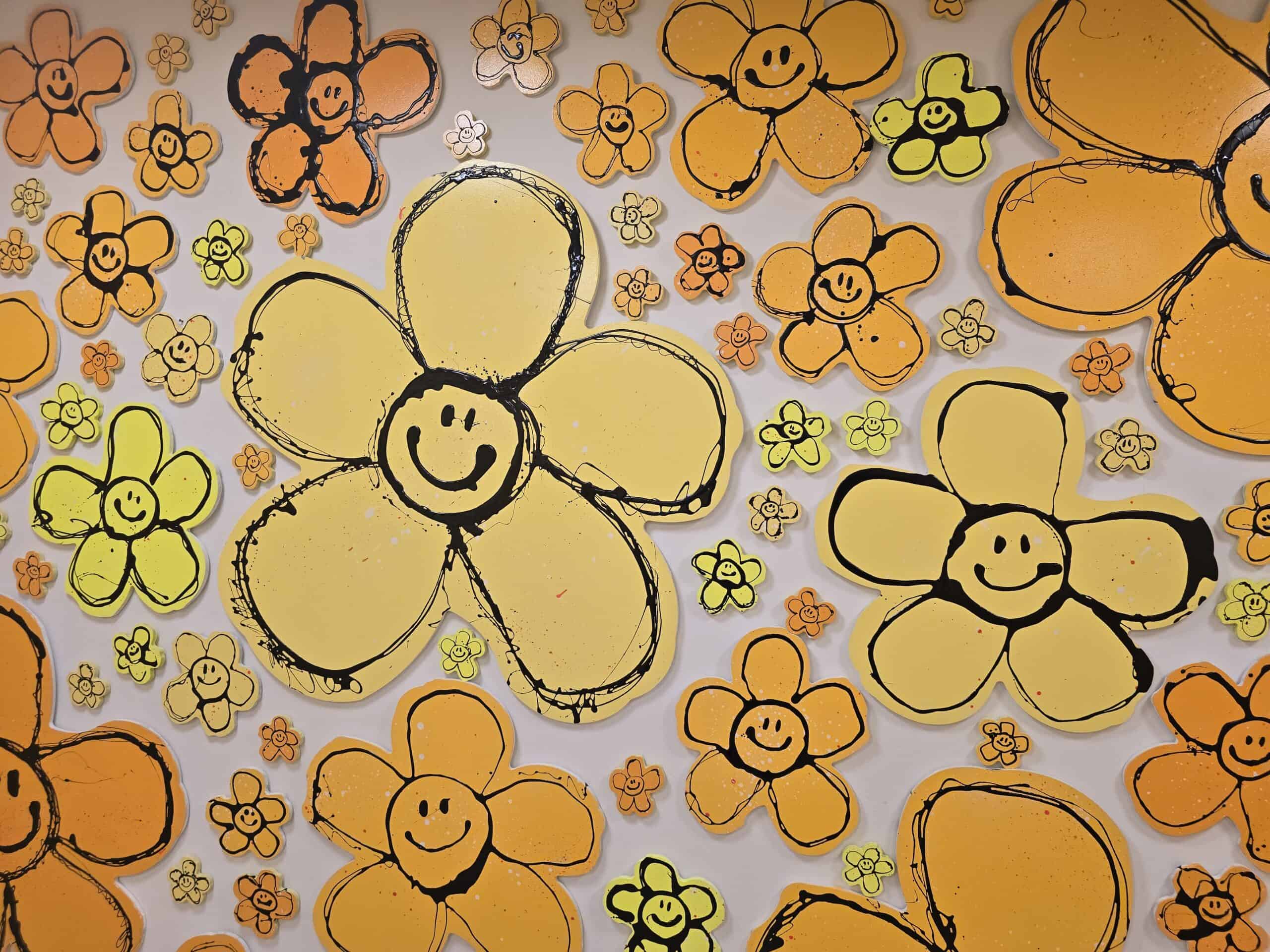
- Your mind is a generative algorithm. The thoughts you feed your mind are the code that creates your reality. Are you programming yourself for growth and vibrant bloom, or for stagnation? This room shows us that while the cycle of growth and setback is inevitable (like the flowers’ endless loop), the nature of that growth: its colour, its form, its resilience, can be shaped by our choices.
- You have agency. Just as your presence makes the digital garden dance, your actions and reactions directly shape or alter the ecosystem of your life. Your movement: your decisions, your intentions alters your environment. You are not just living a pre-written story; you are interacting with it in real-time. Interact with intention.
- Beauty is ephemeral. Life is a cycle of bloom and decay. Embrace the entire process. Extra-Natural is a bridge using the language of our time – technology – to make us more aware of nature’s precious, fragile beauty. It asks us: Can we use our tools not to escape the natural world, but to understand it better, to preserve it, and to forge a new symbiosis?
This room asks us whether we use technology in this digital age,not to escape nature, but to reconnect with its most essential rhythms?
The answer is in the dance. Your dance.
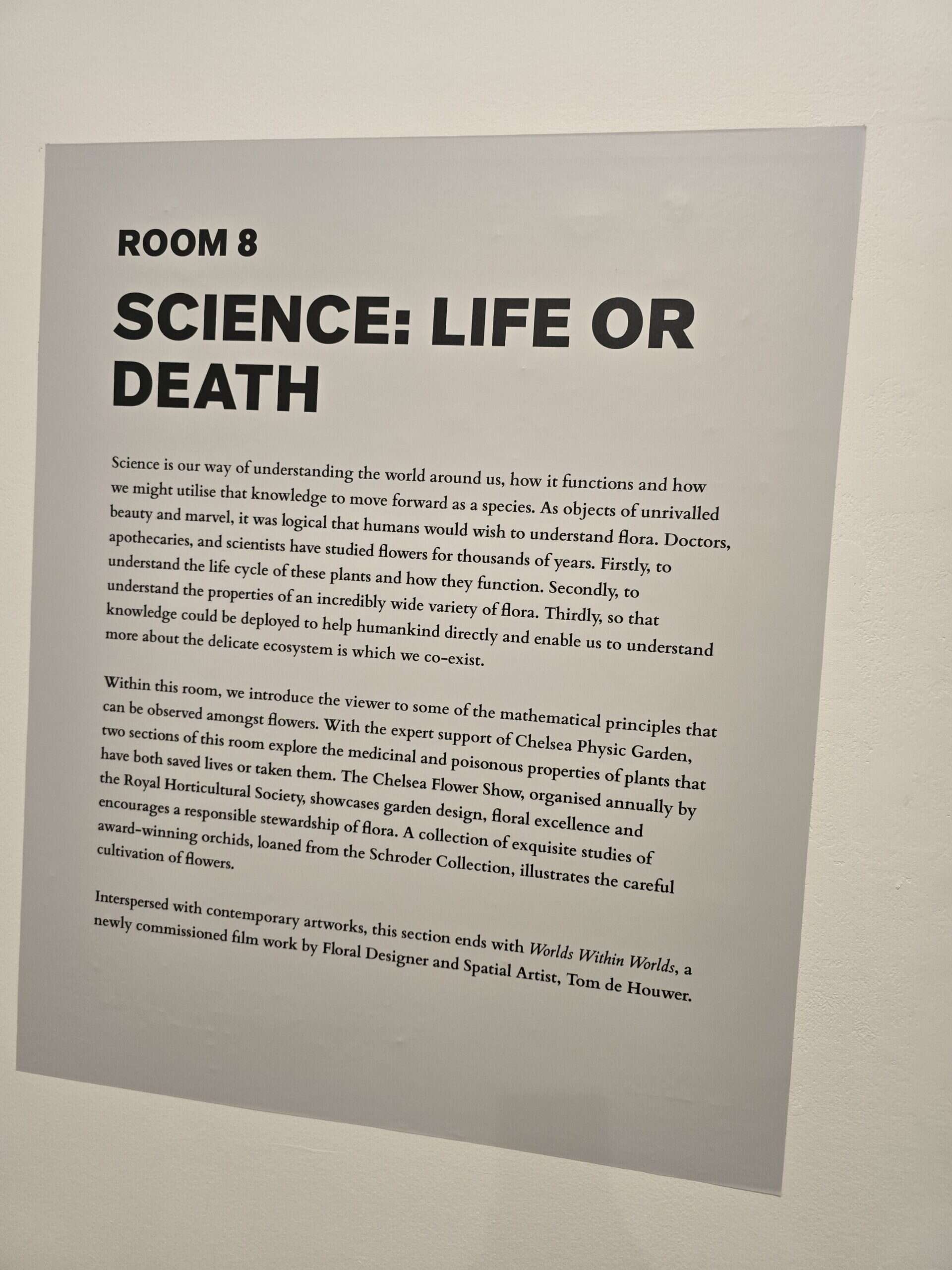
Room 8: Science: Life or Death – Nature’s Double-Edged Petal
Beauty is a precise calculation. In Room 8, the veil of floral elegance is pulled back to reveal nature’s brilliant, and often brutal, intelligence. This is where art meets algorithm, and medicine meets menace. The Pharmacist in me loved this room.
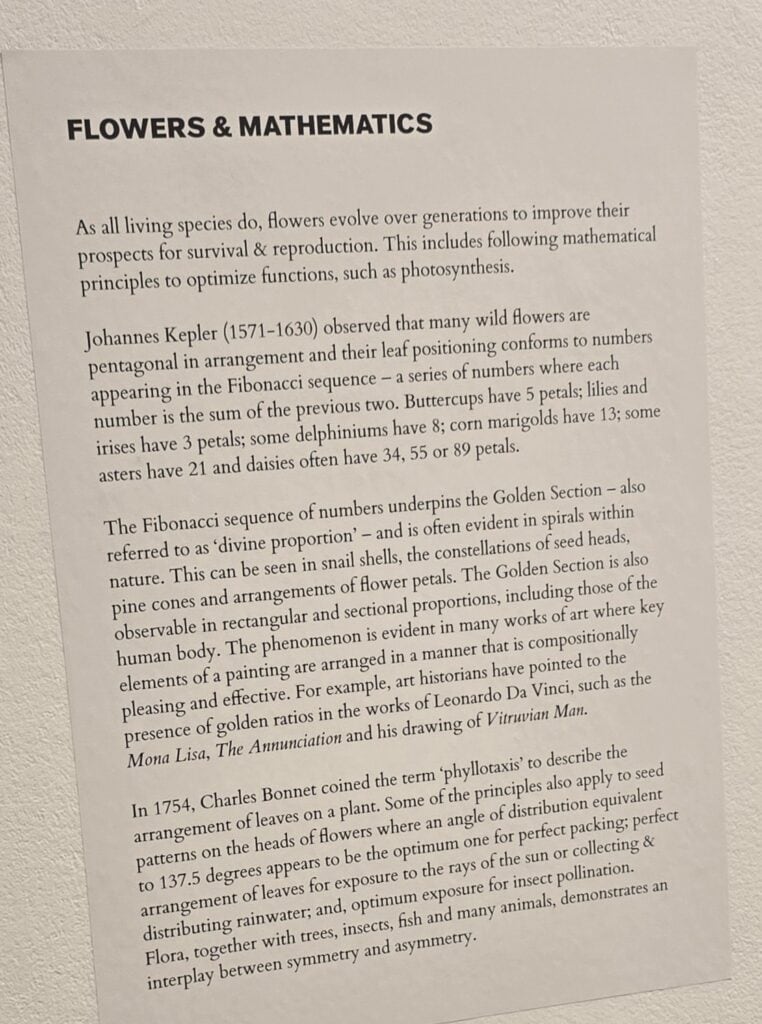
Mathematics: The Hidden Blueprint
Every petal is a masterclass in efficiency. Flowers don’t just grow; they compute. They follow mathematical law – the Fibonacci sequence, the Golden Ratio – to optimize survival. This divine geometry is etched into a sunflower’s spiral, a daisy’s 34 petals, the perfect 137.5-degree angle of a seed head. It is the unseen architecture of resilience, a blueprint for perfection that has evolved over millennia.
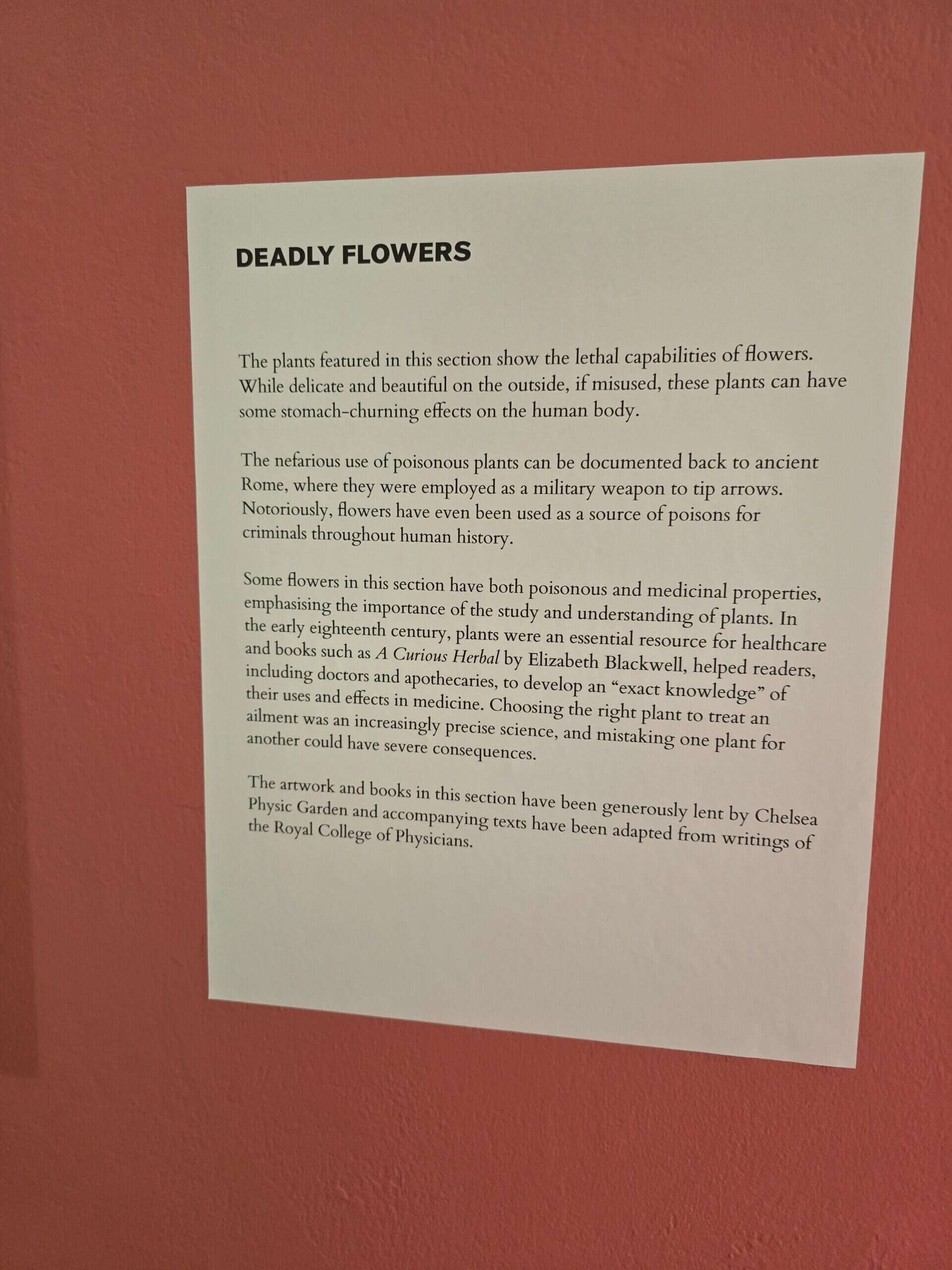
The Ultimate Paradox: Cure and Kill
In the same soil, life and death take root. Here, a single plant can be both poison and antidote, healer and executioner. This room forces us to confront nature’s ultimate paradox:
- Foxglove gives us digitalis, a heart medicine, and a lethal toxin.
- Monkshood, once used on poison arrows, now holds potential for modern medicine.
The difference between remedy and ruin is a matter of dosage, knowledge, and intent. For centuries, this exact knowledge separated the apothecary from the assassin.
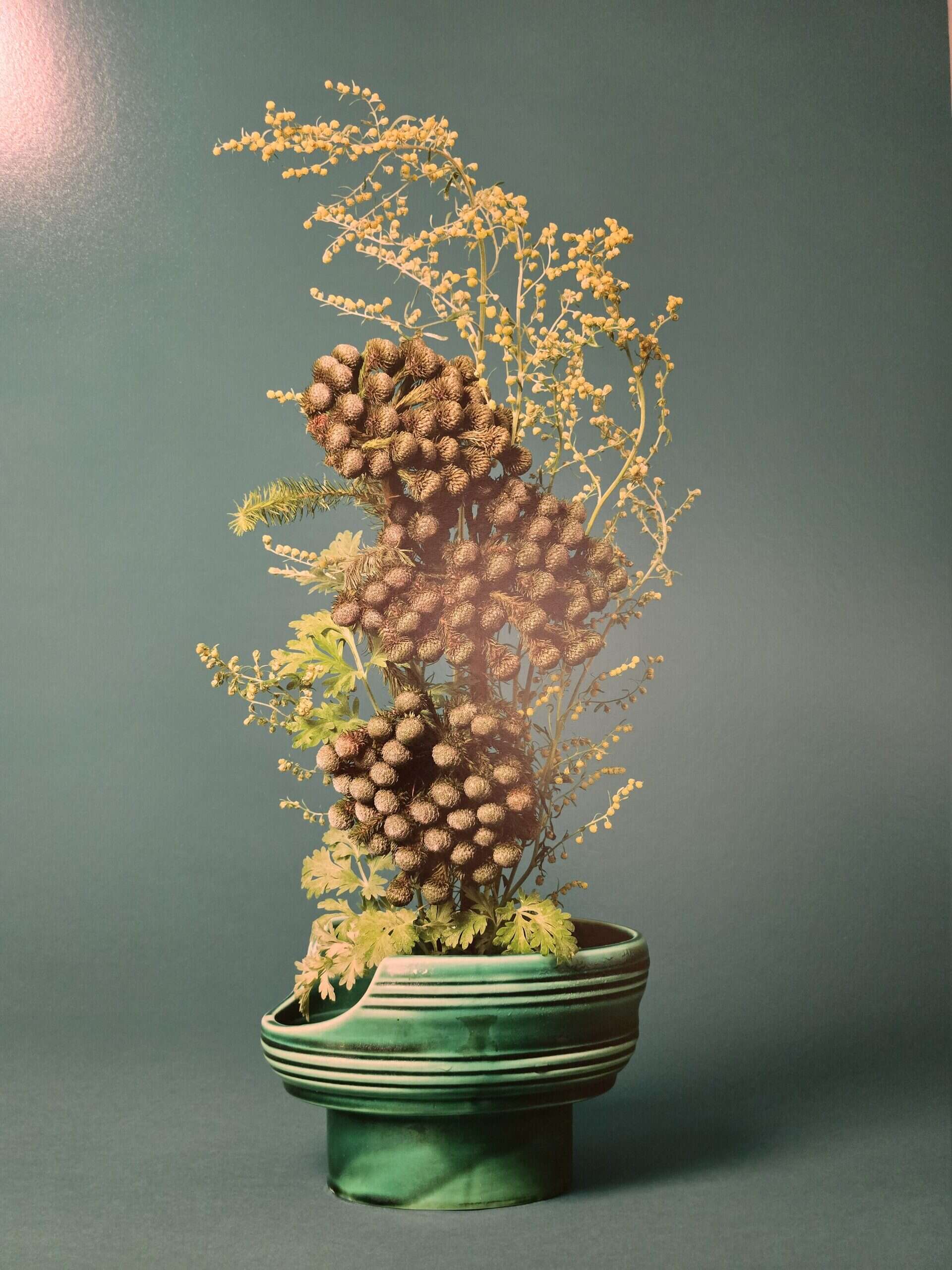
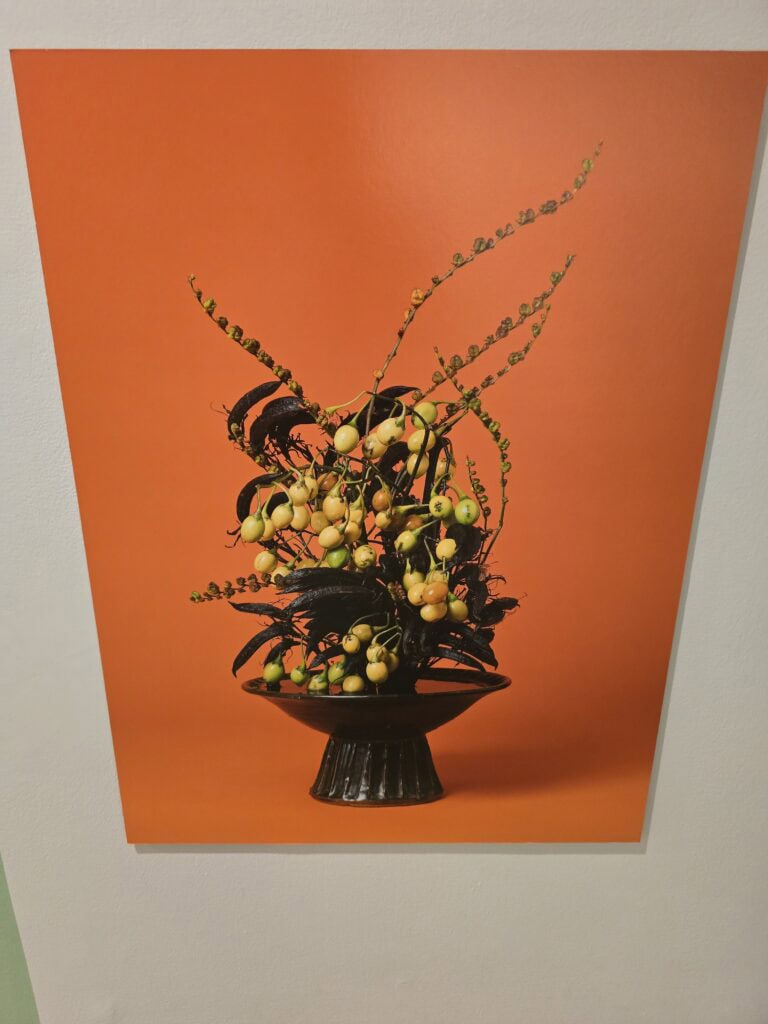
My Reflection: What is your formula for growth?
- Are you built on intentional design? Like the Fibonacci sequence, your daily habits are the underlying code for your success. Structure creates freedom.
- Do you recognize your dual nature? You contain both poison and medicine – the thoughts that heal you and the thoughts that harm you. The power lies in choosing which to administer to yourself.
- Will you seek exact knowledge? Growth requires studying your own patterns, understanding what nourishes you, and identifying what holds the potential to destroy you.
This room proves that nature is the world’s most brilliant scientist and its most efficient killer. Its greatest lesson is one of profound respect: true power lies in understanding the delicate, precise, and often dangerous equations that govern life itself.
The line between a medicine and a poison is simply knowledge. What will you learn about yourself?
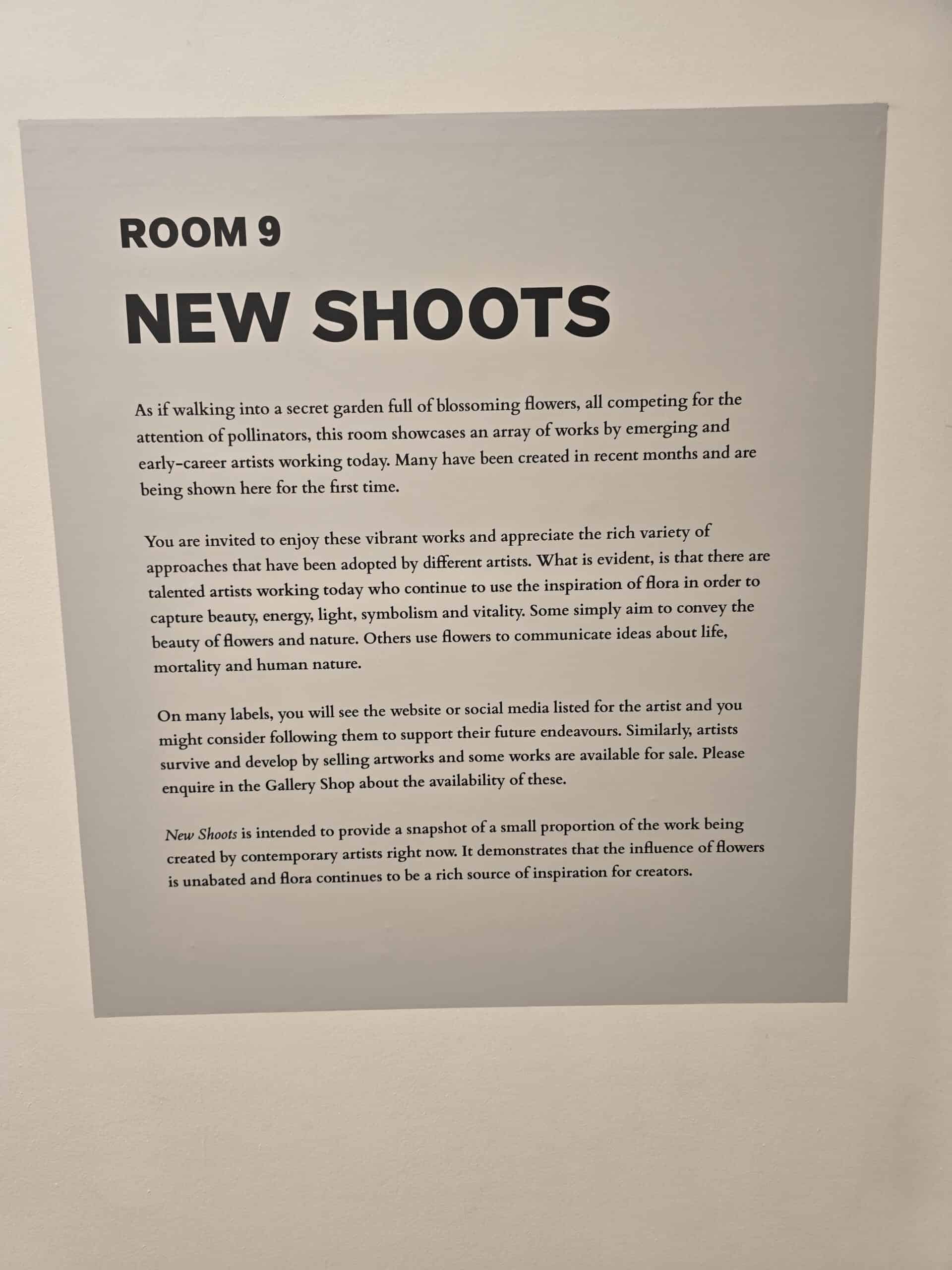
Room 9: New Shoots – The Future in Bloom
This is where the journey comes full circle. After centuries of art, science, and story, we arrive at the source: the new. This room is a vibrant, living gallery of what’s next. It is a secret garden of emerging talent, where the next generation of artists remixes nature’s oldest muse for a modern world.
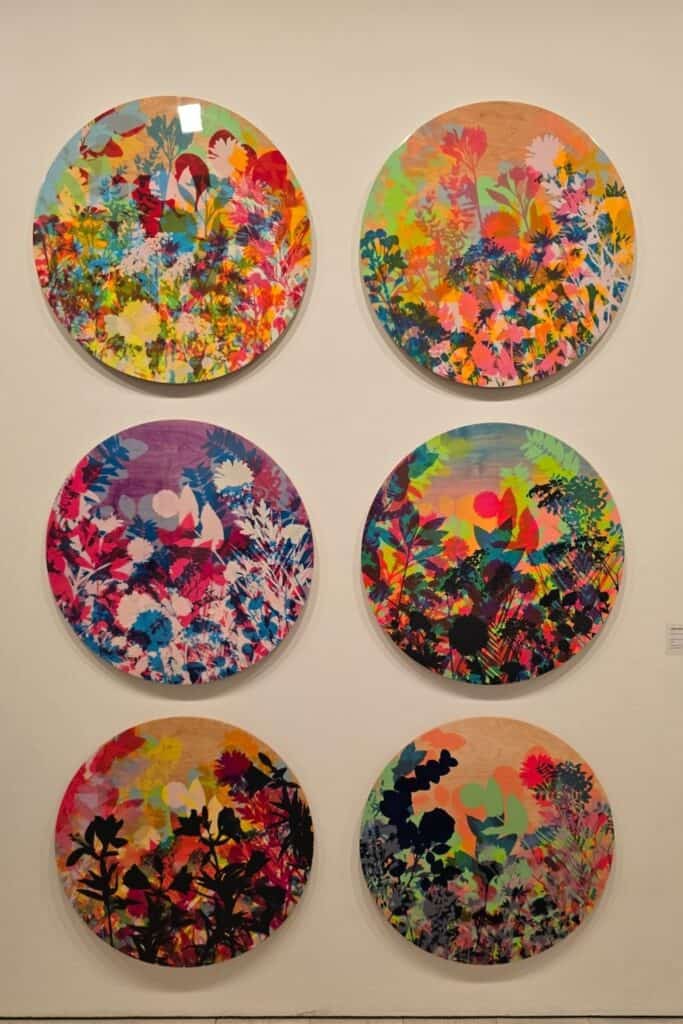
Walk in. Feel the energy. Here, flora is reimagined as a language for capturing light, questioning mortality, and symbolizing raw vitality. These works are as diverse as a wild meadow: each one a unique species competing for your attention, not with pollen, but with perspective.
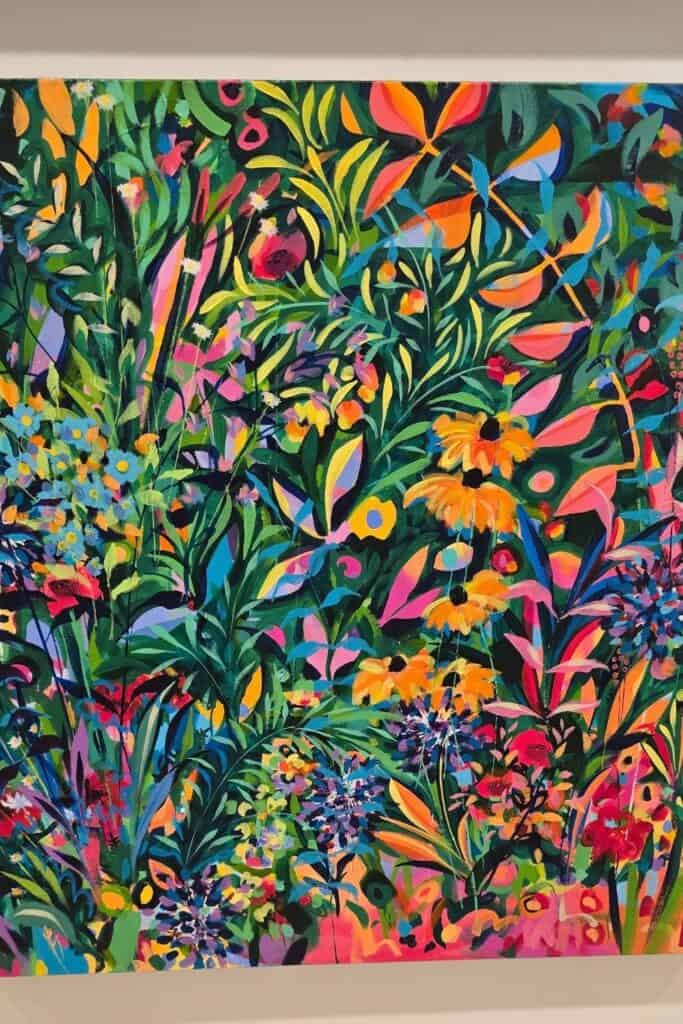
This room is a powerful testament: the influence of flowers is unabated. In an age of algorithms and anxiety, we are still turning to the natural world to make sense of our own. These artists are the essential pollinators of culture, cross-fertilizing traditional inspiration with contemporary technique.
My Reflection: Life calls us to reinvent ourselves again and again. This room is an invitation.
- You Are the Emerging Artist. Your life is your canvas. What new shoot are you nurturing right now? What idea is pushing through your soil, demanding light and attention?
- Embrace Your Unique Bloom. Like every artist here, your perspective is unique. Don’t compare your Chapter 1 to someone else’s Chapter 20. Your growth, your style, your voice matters.
- Support the Growth Around You. Every master was once a beginner. This room challenges us to be patrons of potential; to support, share, and believe in the new shoots around us.
The eternal cycle continues. The old trees provide the shade and soil for the new seeds to rise. This final room proves that inspiration, like a flower, never truly dies. It just finds new ground in which to bloom.
The future of art is here, and it is flourishing. What will you create?
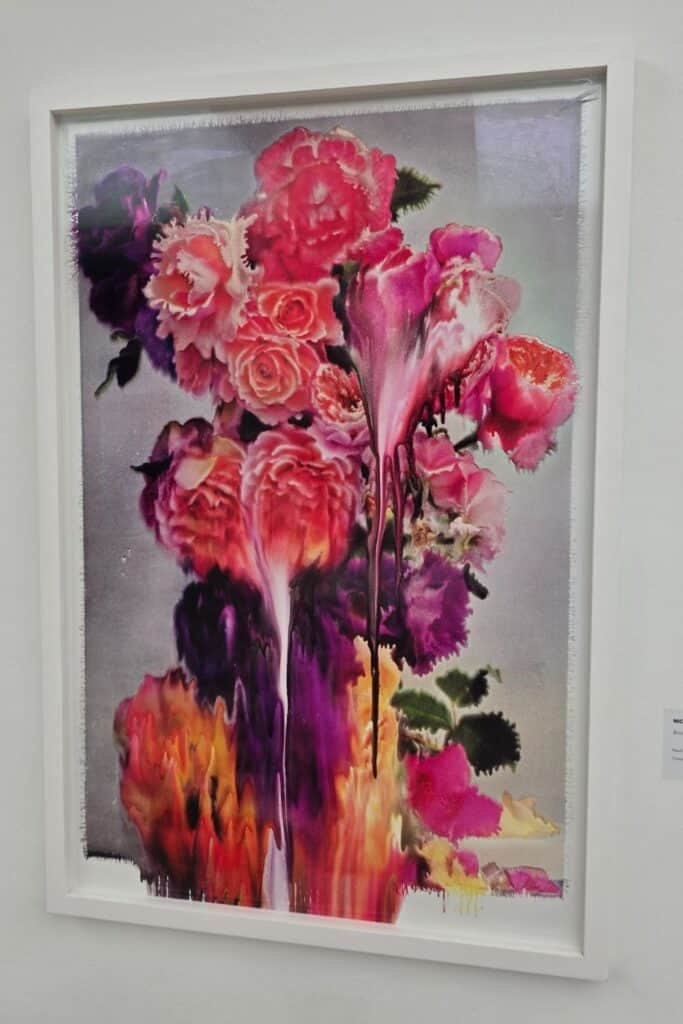
5 Ways To Cultivate A Flower Mindset
- Anchor Your Roots: Ground yourself in your history, values, and early wins. Your roots – like the “Roots” room – nourish growth. Daily rituals like journaling, meditation, or connecting with loved ones keep you steady.
- Cultivate Intentional Growth: Growth happens in stages, not overnight. Set small, deliberate goals and let your progress bloom layer by layer, like a mural slowly coming to life.
- Find Beauty in Transformation: Decay, change, and challenges are part of your story. Even in “dried” moments, your lessons and strength carry richness. Embrace your transitions.
- Adapt and Respond: Resilience isn’t rigid. Like an interactive garden, stay flexible, open, and ready to evolve. Flow with change and invite growth through connection.
- Continuously Reimagine: New shoots always emerge. Stay curious, creative, and willing to reinvent yourself. Every season is a chance to bloom again, brighter than before.
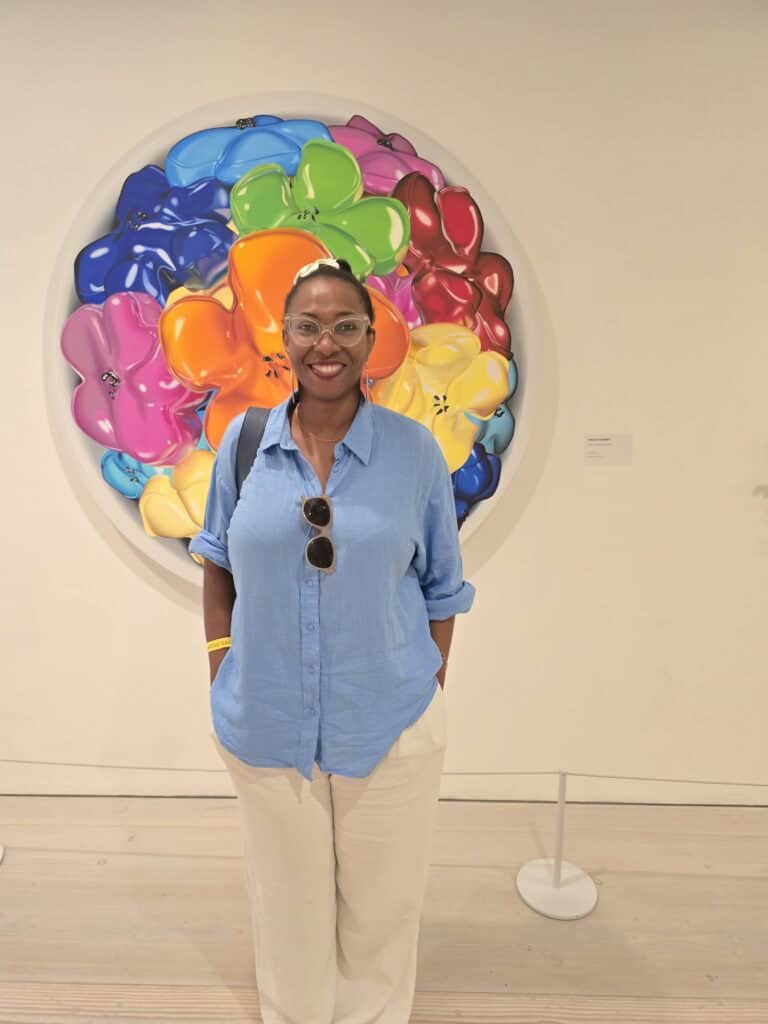
I loved the FLOWERS Exhibition, as evidenced by my photo album and the experience has zoomed its way into my 2025 gratitude journal. Walking through FLOWERS is like walking through life itself: roots, bloom, shadow, renewal, all part of the same journey. To live with intention is to honor your roots, dare to bloom, respect your rhythms, protect your energy, and embrace new beginnings.
Flowers don’t apologize for their cycles. Neither should we.
Whether at Saatchi Gallery before September 9, 2025, or simply in the world outside your window, notice the resilience in every weed, dandelion, or bouquet. See the intention. See the will to thrive. And remember: that same force lives in you.
Root yourself, bloom bravely, and keep growing, always.
Have you visited the exhibition? I’d love to hear what moved you.
Thank you for being a VCC reader.

